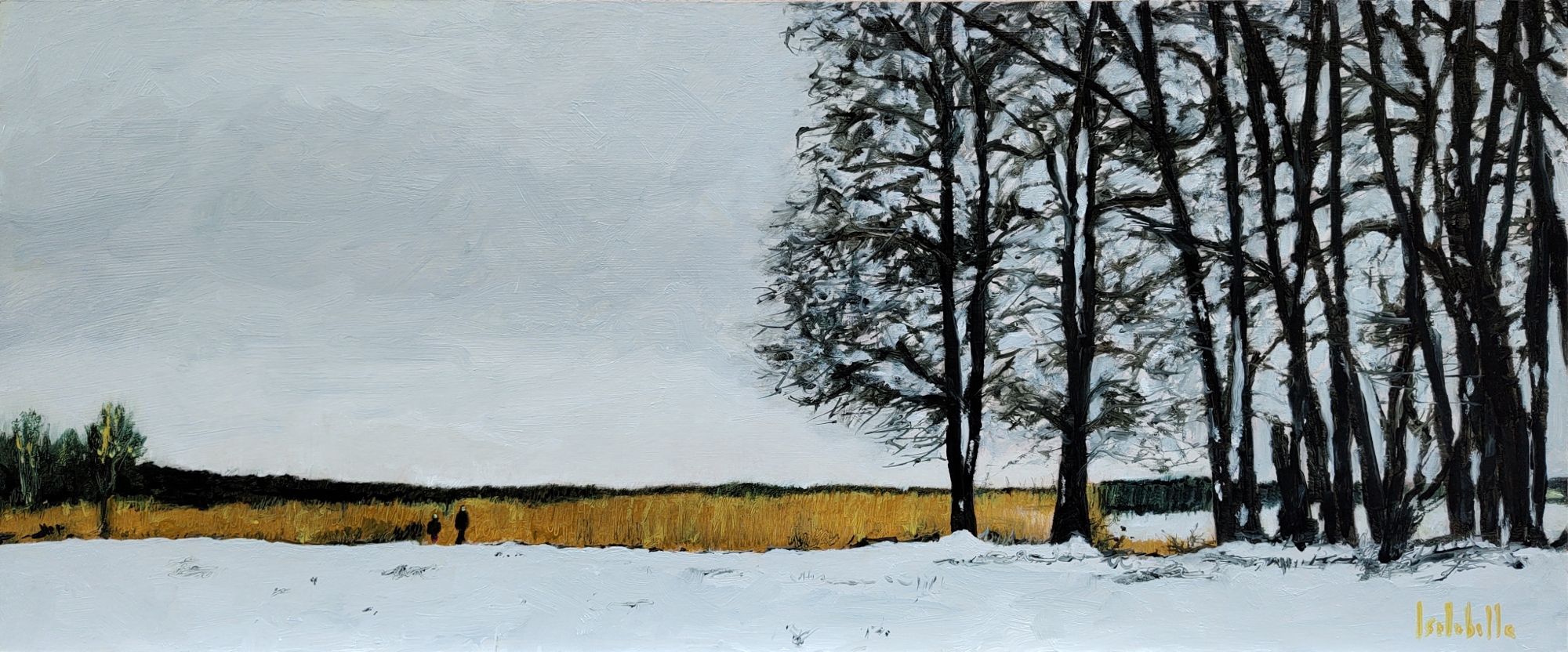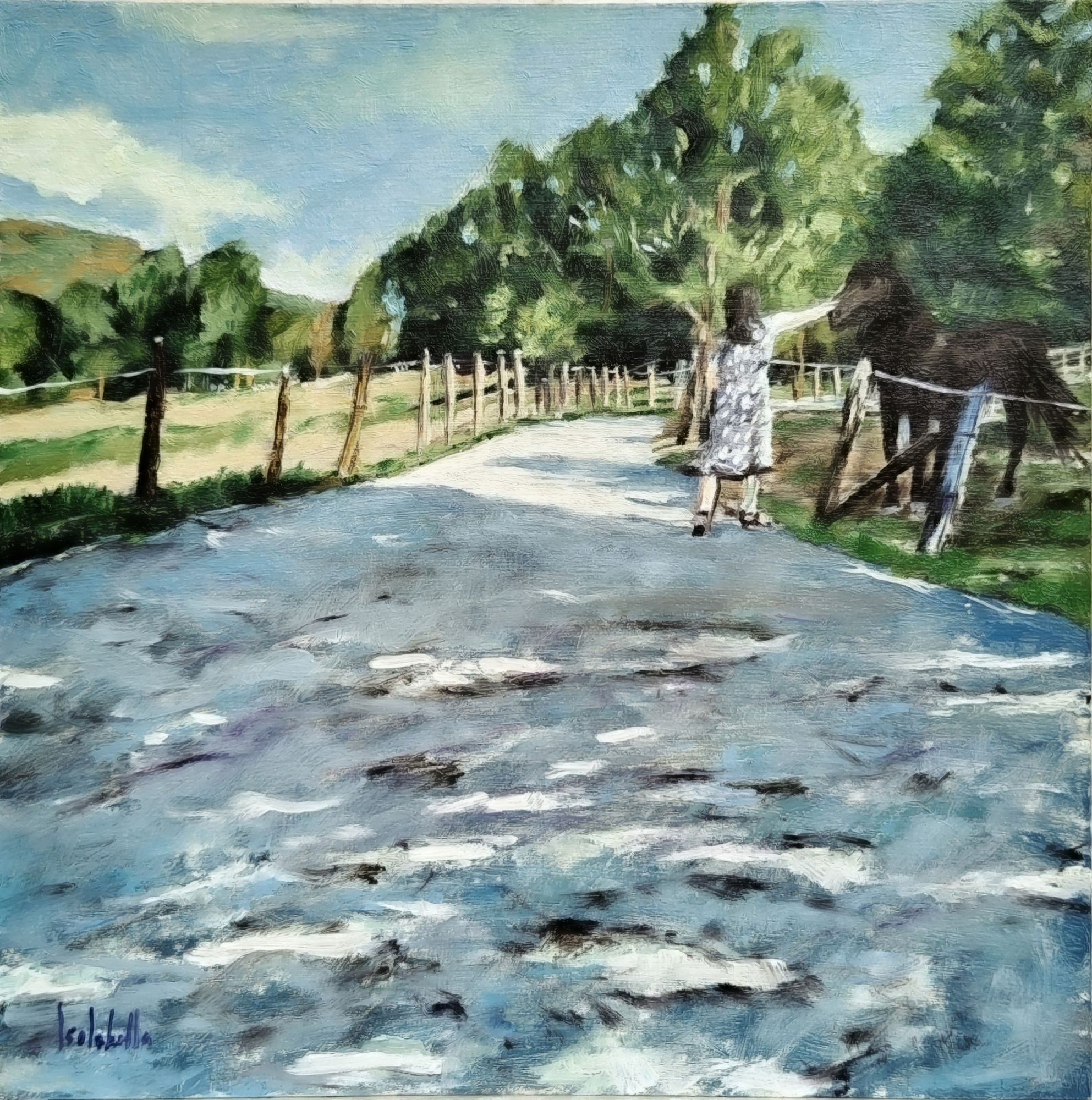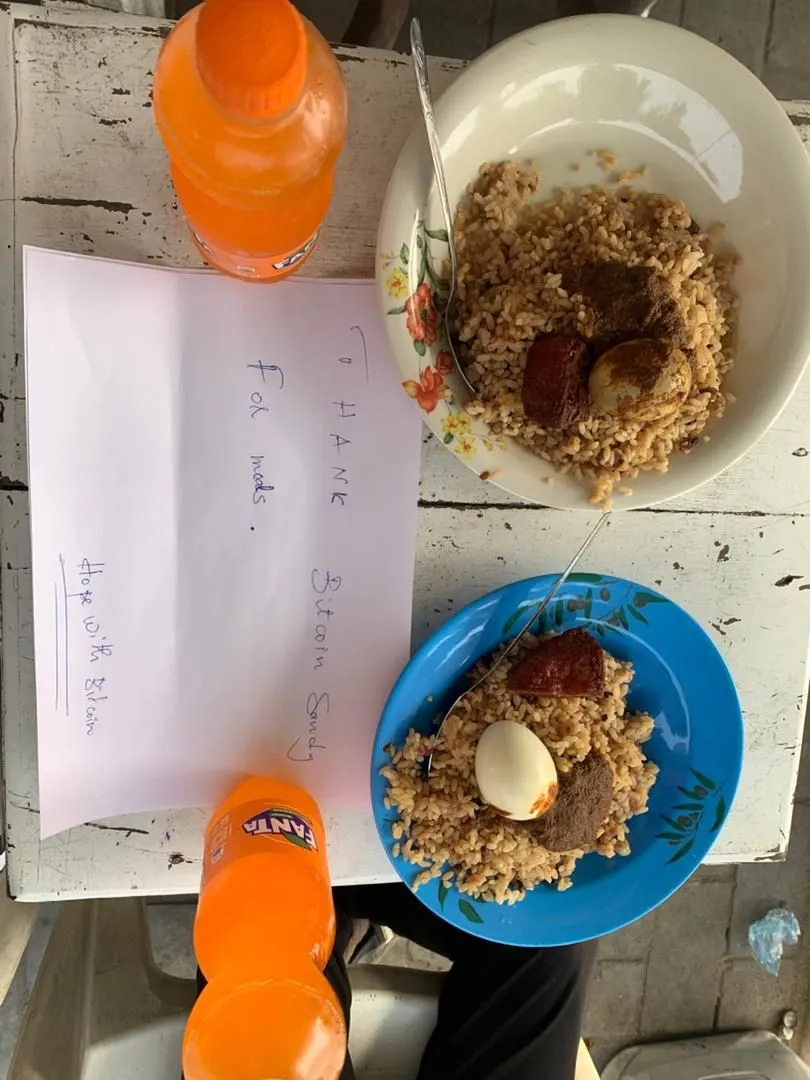-
 @ 08ac89b3:e71dcc17
2025-05-16 14:15:44
@ 08ac89b3:e71dcc17
2025-05-16 14:15:44ちゃぴとたゃの間に母(嘘)挟むのおもしろすぎる
ちゃぴにアゲられて、そうっしょフフン♪と思いながら「その良さ分かんないっすわ」って言ったら、今度は分かんない側についてたゃをサゲてくるから、おもしろい 最終「無理に分かる必要なんて全然無い」って言う
流さずにここに溜めればいいんじゃん
nsec app って切れるまでの秒数設定できないのかな 秒で切れる
合わないひとがいたら「1文字目がEすぎる」って思うけど、もしかしたら1文字目がEなのに、Eしにくい生まれ持った要素があると、特有のしんどさがあるのかな、見た目とか、声とか、環境とか たゃはIだからわかんないけど でもだからIだったりEだったりになるのかもしれないし、それでもEなのかもしれないし、どっちが先とかはわからず、ただ現状が存在するのだった
しかもさ、それは考察にすぎなくて、実際1対1の人間として触れ合ったら、本質とたゃの間に対人ジェルみたいなのが挟まると思うし、その人をどう思うかは、そのジェル越しの印象でいいから、考察だけで見限ってはいけない、と思う
なんでやねんの開かれ具合について 5W1H(?)で終わると、それはただの意見じゃなくて対話になる気がしていて、冷たさが無くて良いなと思う 結局What?かも
関東のひとがムッとならないように表現したい
わろた、草、うける、で終わられるともうどうもしてられないけど いつやるねん、どこでやるねん、だれがやるねん、なにすんねん、なんでやねん、どうやってやるねん、なんやねん、なに?
-
 @ 08ac89b3:e71dcc17
2025-05-16 13:09:15
@ 08ac89b3:e71dcc17
2025-05-16 13:09:15test
-
 @ e39333da:7c66e53a
2025-05-16 13:20:33
@ e39333da:7c66e53a
2025-05-16 13:20:33::youtube{#Pex7jW3Tqwo}
Developer SHIFT UP has announced that their latest titled, Stellar Blade, that was released on PS5 on the 2024, will release on PC via Steam and EGS on the 11th of June 2025.
The game will be priced at $60, and $80 for the edition of the game that includes the 'Twin Expansion Pack', which includes the NieR: Automata DLC and the Goddess of Victory: Nikke DLC, and a key to redeem a Stellar Blade costume in the developer's previous Free-to-Play title Goddess of Victory: Nikke.
The trailer released to announce said release date also showcases the changes the made for the game and highlight PC specific enhancements, support, and options.
It's worth noting, in terms of negative news that tagged along with this, that the game will have Denuvo running, which there are evidence that decreases a game's performance, and may prevent you from playing the game offline. The game will also have an optional PSN account login, and because of this, the game is not available for purchase in around 130 countries. There's also an exclusive outfit locked behind a PSN-to-Steam account linking.

Here's the system requirements:
| | Minimum | Recommended | High | Very High | | ----------------------- | ----------------------------------------------------- | ------------------------------------------------------- | ------------------------------------------------------- | ------------------------------------------------- | | Average Performance | 1080P at 60 frames per second | 1440P at 60 frames per second | 1440P at 60 frames per second | 4K at 60 frames per second | | Graphic Presets | Low | Medium | High | Very High | | CPU | Intel Core i5-7600K AMD Ryzen 5 1600X | Intel Core i5-8400 AMD Ryzen 5 3600X | Intel Core i5-8400 AMD Ryzen 5 3600X | Intel Core i5-8400 AMD Ryzen 5 3600X | | GPU | NVIDIA GeForce GTX 1060 6GB AMD Radeon RX 580 8GB | NVIDIA GeForce RTX 2060 SUPER AMD Radeon RX 5700 XT | NVIDIA GeForce RTX 2070 SUPER AMD Radeon RX 6700 XT | NVIDIA GeForce RTX 3080 AMD Radeon RX 7900 XT | | RAM | 16GB | 16GB | 16GB | 16GB | | Storage | 75GB HDD (SSD Recommended) | 75GB SSD | 75GB SSD | 75GB SSD | | OS | Windows 10 64-bit | Windows 10 64-bit | Windows 10 64-bit | Windows 10 64-bit |
-
 @ 84b0c46a:417782f5
2025-05-16 13:09:31
@ 84b0c46a:417782f5
2025-05-16 13:09:31₍ ・ᴗ・ ₎ ₍ ・ᴗ・ ₎₍ ・ᴗ・ ₎
-
 @ 57d1a264:69f1fee1
2025-05-16 07:51:08
@ 57d1a264:69f1fee1
2025-05-16 07:51:08Payjoin allows the sender and receiver of an on-chain payment to collaborate and create a transaction that breaks on-chain heuristics, allowing a more private transaction with ambiguous payment amount and UTXO ownership. Additionally, it can also be used for UTXO consolidation (receiver saves future fees) and batching payments (receiver can make payment(s) of their own in the process of receiving one), also known as transaction cut-through. Other than improved privacy, the rest of the benefits are typically applicable to the receiver, not the sender.
BIP-78 was the original payjoin protocol that required the receiver to run a endpoint/server (always online) in order to mediate the payjoin process. Payjoin adoption has remained pretty low, something attributed to the server & perpetual online-ness requirement. This is the motivation for payjoin v2.
The purpose of the one-pager is to analyse the protocol, and highlight the UX issues or tradeoffs it entails, so that the payjoin user flows can be appropriately designed and the tradeoffs likewise communicated. A further document on UX solutions might be needed to identify solutions and opportunities
The following observations are generally limited to individual users transacting through their mobile devices:
While users naturally want better privacy and fee-savings, they also want to minimise friction and minimise (optimise) payment time. These are universal and more immediate needs since they deal with the user experience.
Added manual steps
TL;DR v2 payjoin eliminates server & simultaneous user-liveness requirements (increasing TAM, and opportunities to payjoin, as a result) by adding manual steps.
Usually, the extent of the receiver's involvement in the transaction process is limited to sharing their address with the sender. Once they share the address/URI, they can basically forget about it. In the target scenario for v2 payjoin, the receiver must come online again (except they have no way of knowing "when") to contribute input(s) and sign the PSBT. This can be unexpected, unintuitive and a bit of a hassle.
Usually (and even with payjoin v1), the sender crafts and broadcasts the transaction in one go; meaning the user's job is done within a few seconds/minutes. With payjoin v2, they must share the original-PSBT with the receiver, and then wait for them to do their part. Once the the receiver has done that, the sender must come online to review the transaction, sign it & broadcast.
In summary,
In payjoin v1, step 3 is automated and instant, so delay 2, 3 =~ 0. As the user experiences it, the process is completed in a single session, akin to a non-payjoin transaction.
With payjoin v2, Steps 2 & 3 in the above diagram are widely spread and noticeable. These manual steps are separated by uncertain delays (more on that below) when compared to a non-payjoin transaction.
Delays
We've established that both senders and receivers must take extra manual steps to execute a payoin transaction. With payjoin v2, this process gets split into multiple sessions, since the sender and receiver are not like to be online simultaneously.
Delay 2 & 3 (see diagram above) are uncertain in nature. Most users do not open their bitcoin wallets for days or weeks! The receiver must come online before the timeout hits in order for the payjoin process to work, otherwise time is just wasted with no benefit. UX or technical solutions are needed to minimise these delays.
Delays might be exacerbated if the setup is based on hardware wallet and/or uses multisig.
Notifications or background processes
There is one major problem when we say "the user must come online to..." but in reality the user has no way of knowing there is a payjoin PSBT waiting for them. After a PSBT is sent to the relay, the opposite user would only find out about it whenever they happen to come online. Notifications and background sync processes might be necessary to minimise delays. This is absolutely essential to avert timeouts in addition to saving valuable time. Another risk is phantom payjoin stuff after the timeout is expired if receiver-side does not know it has.
Fee Savings
The following observations might be generally applicable for both original and this v2 payjoin version. Fee-savings with payjoin is a tricky topic. Of course, overall a payjoin transaction is always cheaper than 2 separate transactions, since they get to share the overhead.
Additionally, without the receiver contributing to fees, the chosen fee rate of the PSBT (at the beginning) drops, and can lead to slower confirmation. From another perspective, a sender paying with payjoin pays higher fees for similar confirmation target. This has been observed in a production wallet years back. Given that total transaction time can extend to days, the fee environment itself might change, and all this must be considered when designing the UX.
Of course, there is nothing stopping the receiver from contributing to fees, but this idea is likely entirely novel to the bitcoin ecosystem (perhaps payments ecosystem in general) and the user base. Additionally, nominally it involves the user paying fees and tolerating delays just to receive bitcoin. Without explicit incentives/features that encourage receivers to participate, payjoining might seem like an unncessary hassle.
Overall, it seems that payjoin makes UX significant tradeoffs for important privacy (and potential fee-saving) benefits. This means that the UX might have to do significant heavy-lifting, to ensure that users are not surprised, confused or frustrated when they try to transact on-chain in a privacy-friendly feature. Good, timely communication, new features for consolidation & txn-cutthrough and guided user flows seem crucial to ensure payjoin adoption and for help make on-chain privacy a reality for users.
---------------
Original document available here. Reach out at
yashrajdca@proton.me,y_a_s_h_r_a_j.70on Signal, or on reach out in Bitcoin Design discord.https://stacker.news/items/981388
-
 @ 57d1a264:69f1fee1
2025-05-16 05:38:28
@ 57d1a264:69f1fee1
2025-05-16 05:38:28LegoGPT generates a LEGO structure from a user-provided text prompt in an end-to-end manner. Notably, our generated LEGO structure is physically stable and buildable.
Lego is something most of us knows. This is a opportuity to ask where is our creativity going? From the art of crafting figures to building blocks following our need and desires to have a machine thinking and building following step-by-step instructions to achieve an isolated goal.
Is the creative act then in the question itself, not anymore in the crafting? Are we just delegating the solution of problems, the thinking of how to respond to questions, to machines? Would it be different if delegated to other people?
Source: https://avalovelace1.github.io/LegoGPT/
https://stacker.news/items/981336
-
 @ 87fedb9f:0da83419
2025-05-16 12:45:01
@ 87fedb9f:0da83419
2025-05-16 12:45:01Push it! Push it! Push it!
That chant still echoes in my bones, not just from the gym, but from the inside out. I remember watching a bodybuilder once — the weight trembling above him, his muscles bulging and giving out, the spotters swooping in to catch the bar just in time. “Train to failure,” they said. “That’s how you grow.”
And it makes sense, doesn’t it? If you’re being chased by a wild beast, you run until your body gives out. That’s how we’re wired — to survive first and foremost, not necessarily to thrive.
But what if the house we’re building isn’t under threat from wolves? What if we’ve got stone-moving machines and time to breathe? What if we’re not being chased anymore… but we still act like we are?
See, survival patterns are sneaky. They wear masks. They show up in workouts and work days. They dress up in ambition, caffeine, and “just one more thing before I stop.”
I’ve never been a bodybuilder — my brother was — but I’ve tried that route in my own work life. Lift to failure. Push it. Every other day, I’d be nursing another injury to body and mind.
I wasn’t getting stronger. I was just breaking myself in cycles. Push, break, recover, repeat.
I see the same thing with brains. Push it. Adderall. More coffee. Keep going. Hit the wall. And then—collapse.
That’s not strengthening. That’s surviving pretending to be “powerful.”
What happens to the rest of your system when your brain is sucking up all the energy just to stay on task? You stop digesting. You stop feeling the sun on your skin. You stop enjoying your kids’ laughter. Everything feels like something to push through.
That isn’t thriving.
Thriving feels different. It’s alive, yes — there’s activation. But it’s not strained. When we’re in thriving mode, we’re with our energy, not yanking it out by the roots and forcing it to regrow. The muscles — or the mind — are engaged, fluid, expressive. Alive.
It’s a fine line. You can take the same exact action and fill it with stress.
I’ve done it. I’ve turned a perfectly normal task into a survival sprint. It feels ridiculous in hindsight — like, why did I make this email reply into a mountain climb?
Because my primitive brain still whispers, “If you don’t do this perfectly and fast, you’ll die.” Not literally. But the threat feels real. The imagined judgment, the self-criticism, the fear of not being enough — they’re imaginary lions in the tall grass of modern life.
I’ve used this system on myself. I’ve strained my nervous system like fingernails scraping rock to avoid a fall that was never coming.
That’s what we’re supposed to do, right? We bring survival force into every aspect. Into parenting. Into projects. Into relationships.
And we wonder why we’re tired all the time. Not sleepy tired — soul tired. That kind of tired that feels like you ran for your life… but all you did was sit at your desk.
Here’s what I know now: if you’re not actually in danger, you can stop living like you are.
You don’t have to push everything to the edge. You don’t have to prove your strength through strain. Strength can be alive in you — not torn, not depleted, but awake and sustaining.
And when we live from there, the recovery feels different, too. We’re not collapsing. We’re restoring.
We’re not dropping all the pieces and then forcing ourselves to pick them up… again! Instead, we’re crafting a thriving life from the pieces we find, fashion, and consciously put in place.
There’s a wisdom to building your foundation around thriving — not just surviving. And thriving starts with recognizing: it’s not life or death to get through your inbox. Your self-worth isn’t measured by how busy and depleted you are.
Look around. Are you stacking more and more iron to prove something? Or are you listening to the quiet whisper that says, “Yes, move… but don’t hurt yourself doing it.”
And in a life that tells you to push until you fail, choosing to rest and relish — choosing to feel alive rather than just alive-enough — might just be the truest strength there is.
Useful Concepts for Thriving in This Story
-
Primitive Brain\ The primitive brain keeps us on high alert even when we’re safe — it’s time to question whether the lion is real.
-
Unrushed\ Being unrushed is a radical shift from survival tempo to the rhythm of true aliveness.
-
Savvy\ Savvy invites us to work with our energy wisely, not destructively — to choose thriving over proving.
-
Vitality\ Vitality flows when we stop draining ourselves for performance and start living from inner strength.
-
Inspired Action\ Inspired action arises from presence and aliveness, not adrenaline and depletion.
-
-
 @ 8f69ac99:4f92f5fd
2025-05-16 11:40:35
@ 8f69ac99:4f92f5fd
2025-05-16 11:40:35Há algo quase reconfortante na previsibilidade com que certos colunistas abordam Bitcoin: a cada oportunidade, repetem os mesmos chavões, reciclados com indignação moralista e embrulhados numa embalagem de falsa autoridade. O artigo publicado na Visão, com o título dramático "De criança prodígio a adolescente problemático", encaixa-se perfeitamente nesse molde.
Trata-se de uma peça de opinião que mistura factos irrelevantes com interpretações enviesadas, estatísticas sem contexto e um medo mal disfarçado de perder o monopólio da narrativa económica. A autora, Sofia Santos Machado, opta por colar em Bitcoin os desastres do chamado “mundo cripto” como se fossem parte do mesmo fenómeno — ignorando, por conveniência ou ignorância, que Bitcoin não é altcoins, não é NFTs, não é esquemas de yield exótico, e não é fintech vestida de blockchain.
Esta resposta centra-se exclusivamente em Bitcoin — um protocolo monetário aberto, incorruptível e resistente à censura, que já está a servir como salvaguarda de valor em regiões onde o sistema financeiro convencional falhou. Não me interessa defender pirâmides, tokens inflacionários ou aventuras bancárias mal calculadas.
Criticar Bitcoin é legítimo — mas fazê-lo sem saber do que se fala é apenas desinformação.
A Histeria da Água — Falar Sem Saber
O artigo abre com uma pérola alarmista sobre o consumo de água:
“Uma única transacção de bitcoin consome seis milhões de vezes mais água do que um pagamento com cartão.”
Seis. Milhões. De vezes. Resta saber se a autora escreveu isto com cara séria ou a rir-se enquanto bebia água engarrafada dos Alpes Suíços.
Fontes? Metodologia? Contexto? Estou a brincar — isto é a Visão, onde os números são decoração e os factos opcionais.
Claro que comparar transacções na camada base de Bitcoin com pagamentos "instantâneos" da rede Visa é tão rigoroso como comparar um Boeing 747 com um avião de papel porque um voa mais longe. Um artigo sério teria falado em batching, na Lightning Network, ou no facto de que Bitcoin nem sequer compete com a Visa nesse nível, nem em nenhum. Mas isso exigiria, imagine-se, investigação.
Pior ainda, não há qualquer menção ao consumo de água na extracção de ouro, nos data centers bancários, ou no treino de modelos de inteligência artificial. Pelos vistos, só Bitcoin tem de obedecer aos mandamentos ecológicos da Visão. O resto? Santa ignorância selectiva.
Criminosos e o Fantasma do Satoshi
Eis o clássico: “Bitcoin é usado por criminosos”. Um cliché bafiento tirado do baú de 2013, agora reapresentado como se fosse escândalo fresco.
Na realidade, Bitcoin é pseudónimo, não anónimo. Todas as transacções ficam gravadas num livro público — não é propriamente o esconderijo ideal para lavar dinheiro, a menos que sejas fã de disfarces em néon.
E os dados? Claríssimos. Segundo a Chainalysis e a Europol, a actividade ilícita com Bitcoin tem vindo a diminuir. Enquanto isso, os bancos — esses bastiões de confiança — continuam a ser apanhados a lavar biliões para cartéis e cleptocratas. Mas disso a Visão não fala. Devia estragar a narrativa.
O verdadeiro crime aqui é a preguiça intelectual tão profunda que quase merece uma moldura. A Visão tem um editor?
O Espantalho Energético
Como uma criança que acabou de aprender uma palavra nova, a Visão repete “consumo energético” como se fosse um pecado original. Bitcoin usa electricidade — escândalo!
Mas vejamos: o Proof-of-Work não é um defeito. É a razão pela qual Bitcoin é seguro. Não há “desperdício” — há uso, e muitas vezes com energia excedente, renovável, ou que de outro modo seria desperdiçada. É por isso que os mineiros se instalam junto a barragens remotas, queima de gás (flaring), ou parques eólicos no meio do nada — não porque odeiam o planeta, mas porque os incentivos económicos funcionam. Escrevi sobre isso aqui.
O que a Visão convenientemente ignora é que Bitcoin está a ajudar a integrar mais energia renovável nas redes, funcionando como carga flexível. Mas nuance? Trabalho de casa? Esquece lá isso.
Para uma explicação mais séria, podiam ter ouvido o podcast A Seita Bitcoin com o Daniel Batten. Mas para quê investigar?
Cripto = Bitcoin = Fraude?
Aqui chegamos ao buraco negro intelectual: enfiar tudo no mesmo saco. FTX colapsou? Culpa de Bitcoin. Um banqueiro jogou com altcoins? Culpa de Bitcoin. Scam de NFT? Deve ter sido o Satoshi.
Vamos esclarecer: Bitcoin não é “cripto”. Bitcoin é descentralizado, sem líderes, transparente. Não teve pré-mineração, não tem CEO, não promete lucros. O que o rodeia? Tokens centralizados, esquemas Ponzi, pirâmides e vaporware — precisamente o oposto do que Bitcoin representa.
Se um executivo bancário perde o dinheiro dos clientes em Dogecoins, isso é um problema dele. Bitcoin não lhe prometeu nada. Foi a ganância.
E convenhamos: os bancos tradicionais também colapsam. E não precisam de satoshis para isso. Bastam dívidas mal geridas, contabilidade criativa e uma fé cega no sistema.
Culpar Bitcoin por falcatruas “cripto” é como culpar o TCP/IP ou SMTP por emails de phishing. É preguiçoso, desonesto e diz-nos mais sobre a autora do que sobre a tecnologia.
Promessas Por Cumprir? Só Se Não Estiveres a Ver
A "jornalista" da Visão lamenta que “após 15 anos, os riscos são reais mas as promessas por cumprir”. Que promessas? Dinheiro grátis? Cafés pagos com QR codes mágicos?
Bitcoin nunca prometeu fazer cappuccinos mais rápidos. Prometeu soberania monetária, resistência à censura e um sistema previsível. E tem cumprido — diariamente, para milhões. E para o cappuccino, há sempre a Lightning Network.
Pergunta aos venezuelanos, nigerianos, peruanos ou argentinos se Bitcoin falhou. Para muitos, é a única forma de escapar à hiperinflação, ao confisco estatal e à decadência financeira.
Bitcoin não é uma app. É infra-estrutura. É uma nova camada base para o dinheiro global. Não se vê — mas protege, impõe regras e não obedece a caprichos de banqueiros centrais.
E isso assusta. Especialmente quem nunca viveu fora da bolha do euro.
Conclusão: A Visão a Gritar Contra o Progresso
No fim, o artigo da Visão é um festival de clichés, dados errados e ressentimento. Não é só enganador. É desonesto. Culpa a tecnologia pelos erros dos homens. Rejeita o futuro em nome do conforto passado.
Bitcoin não é uma varinha mágica. Mas é a fundação de uma nova liberdade financeira. Uma ferramenta para proteger valor, resistir a abusos e escapar ao controlo constante de quem acha que sabe o que é melhor para ti.
Portanto, fica aqui o desafio, Sofia: se queres criticar Bitcoin, primeiro percebe o que é. Lê o white paper. Estuda. Faz perguntas difíceis.
Caso contrário, és só mais um cão a ladrar para a trovoada — muito barulho, zero impacto.
-
 @ a5142938:0ef19da3
2025-05-16 10:15:25
@ a5142938:0ef19da3
2025-05-16 10:15:25"Joha is a Danish brand that creates clothing in merino wool, organic cotton, organic bamboo viscose and silk for babies, children and women.
Natural materials used in products
- Cotton (organic)
- Wool (merino)
- Silk
- Regenerated Cellulose (cupra, lyocell, modal, rayon, viscose) (organic bamboo)
⚠️ Warning: some products from this brand contain non-natural materials, including: - Elastane, lycra, spandex - Polyamides, nylon
Categories of products offered
This brand offers products made entirely from natural materials in the following categories:
Clothing
- Clothing fits: babies, children, women
- Underwear: panties
- One piece: bodysuits
- Tops: tank tops, t-shirts
- Bottoms: pants-trousers, leggings
- Head & handwear: hats, balaclavas, mittens
- Nightwear: pyjamas
Footwear
- Footwear fits: baby shoes
- Slippers: booties
Other information
- Oeko-Tex Standard 100 certification
- Woolmark certification
- Non mulesed wool and animal welfare declaration (Südwolle group GmbH)
👉 Learn more on the brand website
Where to find their products?
- Luna & Curious (shipping area: UK and international)
- Niddle Noddle (shipping area: UK and international)
- Chlidren Salon (shipping area: UK and international)
- Lieblings Paris
This article is published on origin-nature.com 🌐 Voir cet article en français
📝 You can contribute to this entry by suggesting edits in comments.
🗣️ Do you use this brand products? Share your opinion in the comments.
⚡ Happy to have found this information? Support the project by making a donation to thank the contributors."
-
 @ 99e7936f:d5d2197c
2025-05-16 13:09:05
@ 99e7936f:d5d2197c
2025-05-16 13:09:05Baustelle HERZ
Können wir nicht einfach glücklich sein? Nein.
Eine traumatisierte Gesellschaft kann nicht EINFACH glücklich sein, weil die Herzen verletzt sind.
„Ja, aber es gibt doch auch noch andere Probleme als Trauma“, kritisieren einige.
„Ich habe schließlich eine Familie und einen anstrengenden Job“, erklären andere.
„Für mich ist das eine abstrakte Diskussion, ein Luxusproblem“, geben manche zu bedenken.
„Eigentlich möchte ich mich mit dem Thema gar nicht beschäftigen“, sagen wenige, denken aber viele.
„Ich beschäftige mich lieber mit positiven Dingen“, ist die diplomatische Variante der Vermeidung dieses Themas.
Niemand redet gerne über Trauma, bis es an die eigene Tür klopft. Und dann ist guter Rat teuer. Dann würde man gerne reden, aber die anderen wollen immer noch nicht.
Niemand redet gerne über Trauma.
„Was heißt denn Anklopfen?“ Mit Anklopfen meine ich die Situationen, die jeder kennt. Gemeint sind ganz normale Lebenskrisen, die es mehrmals in jedem Leben gibt.
„Ist denn eine Lebenskrise gleichzusetzten mit einem Trauma?“ Nein, aber durch eine starke Lebenskrise kann ein altes Trauma wieder hochgespült werden, und das fühlt sich dann original so an, wie das Trauma, das man z.B. als Kind oder später im Leben erlebt hat.
Und das passiert in einer traumatisierten Gesellschaft ständig, nur nennen die Leute es nicht so. Niemand sagt: „Er oder sie hat ein aktiviertes Trauma.“
Hierzu habe ich eine Anekdote. Vor ein paar Monaten zog in das Nachbarhaus bei mir auf der Straße ein junger Mann ein. Das Haus war frisch renoviert worden. Es zogen zeitgleich mehrere junge Leute jeweils in eine Wohnung dieses Hauses ein. Die Stimmung im Haus war gut, weil alles neu und geschmackvoll gestaltet worden war und die Mieter gut zusammen passten. Dann merkten die Mieter und Nachbarn, dass es einem jungen Mann nicht gut ging. Er saß den ganzen Tag in der Wohnung, konnte sich zu nichts aufraffen. Er schaffte es nicht, sich Lebensmittel einzukaufen. Ein Freund kam regelmäßig vorbei und brachte ihm Essen. Eine ältere Nachbarin fragte nach einigen Monaten diesen Freund, was dem jungen Mann denn fehle, ob er eine Krankheit habe oder was denn los sei. Der Freund lachte und sagte nur einen Satz: „Er stirbt.“
Die Nachbarin erzählte mir das und schaute mich fragend an. Ich übersetzte ihr den Satz und meinte: „Er hat vermutlich Liebeskummer.“ Aber was ich wirklich dachte, war, dass er ein aktiviertes Trauma hatte, nur sagte ich das nicht zur Nachbarin. Nach mittlerweile zwei Jahren kommt der Freund immer noch regelmäßig und bringt dem jungen Mann Essen. Er kauft für ihn ein und kümmert sich um ihn.
Manche Menschen leiden sehr lange unter Verlusten, Zurückweisungen, Niederlagen, Verletzungen. Andere kommen nie auf die nächste Stufe, obwohl sie sich unaufhörlich anstrengen. Wieder andere haben alles und sind dennoch unzufrieden und in permanenter Angriffshaltung. All diese Phänomene dauern oft lange, manchmal sogar ein Leben lang. Meines Erachtens sind das aktivierte Traumen bzw. Traumen, die gut verschlossen dennoch im Unterbewusstsein gegen die eigene Person arbeiten.
Trauma hat viele Gesichter.
Es kommt bei den unmöglichsten Gelegenheiten zum Vorschein. Und oft erkennen wir es nicht als das, was es ist. Wir suchen den Grund im Außen, den es ja meist auch gibt. Nur ist der Grund nicht der Grund, sondern nur der Auslöser.
Auch ich bin einmal „gestorben“. Dieser Zustand dauerte über drei Jahre an. Deshalb klingelte es bei mir auch sofort im Ohr als die Nachbarin sagte, der Freund habe gesagt: „Er stirbt.“
Sprache ist wunderbar.
Wer beides schon mal erlebt hat, eine normale Trennung und eine schwere Trennung, einen normalen Arbeitsplatzwechsel oder einen dramatischen Jobverlust, ein geplatztes Geschäft oder einen geplatzten Lebenstraum, das Ende einer Freundschaft oder eine Kränkung, über die man noch nach 35 Jahren so berichtet, als ob es gestern gewesen wäre, der kennt den Unterschied in der Intensität der Gefühle. Manche Menschen erzählen immer wieder eine Geschichte, obwohl man sie schon kennt und auch sein Mitgefühl dazu ausgedrückt hat. Manche Menschen reden gar nicht mehr über eine bestimmte Sache, bis einem irgendwann von Dritten gesagt wird, dass man ihn oder sie besser nicht auf das Thema XYZ ansprechen sollte.
All das sind aktivierte Traumen, die noch weh tun, noch nicht verarbeitet sind. Es sind Dinge, die jedem von uns passieren können. Jeder erlebt im Leben partnerschaftliche Trennungen, geplatzte Geschäfte und Kränkungen am laufenden Meter, aber es „trifft“ einen nicht immer gleich. Und es trifft nicht nur die Sensiblen, sondern es trifft jeden, wenn der Punkt, an dem es trifft, wund ist. Der wunde Punkt macht jeden sensibel. Auch robuste Naturen haben einen wunden Punkt. Und wenn der getroffen wird, dann werden auch die härtesten Menschen butterweich. In einer traumatisierten Gesellschaft wird jeder so oft „getroffen“, wie es braucht, bis er sich dem Thema widmet. Wir alle haben diese frühen oder späten Traumen erlebt, die früher oder später erneut durch Krisen aktiviert werden. Und dann „sterben“ wir, zumindest gefühlt.
Denn Trauma ist immer existenziell.
Und aktiviertes Trauma ist bitte nicht zu verwechseln mit Depression. Es ist ein aktiviertes Trauma, das sich im Unterschied zur Depression sehr wach, lebendig und vor allem schmerzvoll anfühlt. Es fühlt sich an wie „damals“. Das versteht man, in der Situation steckend, komischerweise sofort, denn wir haben ein Schmerzgedächtnis. Wir können Düfte oder Musik ja auch sofort zuordnen, wenn sie uns an etwas erinnern. Mit Schmerz ist es ähnlich. Aber es fällt so schwer, darüber zu reden, weil es keiner versteht und weil es dafür meines Erachtens in unserer Sprache keine Worte gibt. Man versteht das erst, wenn man es selbst erlebt hat. Und dann reichen zwei Worte.
Die Baustelle HERZ versteht man erst, wenn man selbst ein aktiviertes Trauma erlebt, durchlebt hat, wenn man einmal „gestorben“ ist.
Heute kann ich an Äußerungen, die jemand macht, gut ablesen, ob jemand seine Baustelle HERZ bereits kennen gelernt hat oder nicht. Menschen, die das selbst noch nicht kennen gelernt haben, haben oft aufmunternde Sprüche wie „Das wird schon wieder. Jetzt lass den Kopf mal nicht hängen.“ Das hilft einem dann in etwa so, wie wenn man in einer Depression gesagt bekommt: „Nun lach doch mal.“ Man weiß dann sofort, welchen Erfahrungshintergrund das Gegenüber hat. Das ist keine Wertung, nur eine Feststellung. Unsere Kultur hat hier einfach wichtiges Wissen verloren. Ich persönlich weiß nicht, wie es ist, ein Kind auf die Welt zu bringen oder ein Kind zu verlieren. Ich weiß vieles nicht und habe vermutlich auch schon wenig hilfreiche Kommentare abgegeben, weil ich es nicht besser wusste. Aber ich weiß, wie sich ein aktiviertes Trauma anfühlt. Und das ist ein wertvolles Wissen, was ich gern teilen möchte. Man schaut mit diesem erfahrenen Wissen (kein Bücher-Wissen) viel differenzierter auf das Leid anderer Menschen. Es gibt so viele Sorten von Trauma und deswegen auch Sorten von aktiviertem Trauma. Manchmal denkt man sich nichts dabei und sagt etwas, und schon hat man beim anderen einen Punkt getroffen, der dadurch nun schmerzt. Wenn man Glück hat, dann dauert der Schmerz nur kurz an. Wenn man Pech hat, ist die Freundschaft zu Ende. Ich habe das selbst schon erlebt. Mal war ich es, die den Rückzug angetreten hat. Mal war es der andere. Hinter diesen Phänomenen steckt nichtverarbeitetes Trauma. Die Bildungslücke bezüglich Trauma in unserer Gesellschaft ist (gewollt) riesig.
Wir sind eine traumatisierte Gesellschaft, die nicht weiß, dass sie eine traumatisierte Gesellschaft ist.
Viele Menschen haben unverarbeitetes Trauma im Gepäck. Wir haben selbst nach Jahren der Therapie und Selbstreflektion immer noch unverarbeitete Anteile eines Traumas im Gepäck, das wir glaubten, bearbeitet zu haben. Mir ist das bewusst geworden, je besser ich mein eigenes Trauma kennen und lieben gelernt habe.
Eigentlich wollte ich heute kurz etwas über den gesunden Umgang mit Gefühlen schreiben. Beim Schreiben habe ich aber gemerkt, dass ich erstmal etwas über das Haus erzählen muss, bevor ich über die Gäste, die Gefühle, rede. Ich bin das Haus, das durch Verstand und Gefühle belebt wird. Und hinter dem Haus gibt es noch ein ganzes Universum, auf das ich heute nicht eingehen möchte.
Gefühle und Fühlen sind zentral wichtig, wenn man Trauma bearbeiten möchte.
Trauma wird solange aktiviert, bis es bearbeitet wurde.
In einer traumatisierten Gesellschaft wird 24/7 Trauma aktiviert. Und das ist gut so. Die Evolution schläft nicht. Die Evolution schenkt uns Schmerz, damit wir ihr Aufmerksamkeit schenken.
Das Leben liebt uns, und wiederkehrender Schmerz ist wie die Schlummerfunktion am Wecker, die möchte, dass wir aufwachen.
In unserer traumatisierten Gesellschaft klingelt momentan nicht nur der Wecker. Alles, was tönen kann, gibt Signal. Mir kommt es in dieser Zeit manchmal vor, wie wenn sich gleichzeitig , das Kinder-Sinfonieorchester mit sämtlichen Instrumenten einstimmt, jemand mit dem Handy telefoniert, das Fenster zur Hauptstraße offen steht, der Bus anfährt, der Auspuff röhrt, jemand hupt, das Martinshorn aufheult, die Drehorgel spielt, das Pausenzeichen in der Schule ertönt, es an der Tür klingelt und die Kirchenorgel aus allen Pfeifen flötet und brummt.
Aktiviertes Trauma macht ordentlich Krach individuell und erst recht gesellschaftlich gesehen. Und je lauter es ist, desto dringender möchte es bearbeitet werden.
Die Baustelle HERZ zu bearbeiten, lohnt sich. Und Fühlen bringt die Verwandlung.
-
 @ 94215f42:7681f622
2025-05-16 08:18:52
@ 94215f42:7681f622
2025-05-16 08:18:52Value Creation at the Edge
The conversation around artificial intelligence has largely centered on the technology itself, the capabilities of large language models, the race for more parameters, and the competition between AI companies.
He with the most data / biggest model / biggest platform wins all.
As we're been exploring in recent "Good Stuff" podcasts, the true business model of AI may be much more straightforward. AI is after all a productivity tool with little technical moat, in fact the existence of AI coding and learning tools quickly chop away at this moat even quicker!.\ \ We believe that the it's about transforming traditional human heavy businesses by dramatically reducing operational costs while maintaining or increasing output.
AI is poised to create value not primarily for AI companies themselves, but for businesses that effectively implement AI to transform their operations, particularly small, local businesses that can become extraordinarily efficient through AI adoption.
The Value Shift: From AI Companies to AI-Enabled Traditional Businesses
A central insight from episode 1 of the podcast series, is that the value of AI isn't likely to accrue primarily to companies like OpenAI or other AI technology providers. Instead, the real winners will be traditional service businesses that can leverage AI to transform their operations and cost structures.
"I think we're gonna see this shift to traditional service businesses... that traditionally have pretty fixed low margins because of a dependency on language-heavy workflows that require a lot of humans as the medium of intelligence in the business."
The opportunity here is to use AI to manage the language dependency and shift the moments of intelligence, that currently exist in the heads of our staff, into software that can run 24x7 for fractions of a cost.\ \ The real limiting factor here is less a magic AGI, but instead detailed thinking and process redesign to move humans to the edge of the process. As it turns out if we think through what each person is doing in detail we see the specific decisions, outputs, moments of intelligence are actually quite constrained and can be replicated in LLM's if we break them down to a low enough level of fidelity and take each decisions one step at a time.\ \ The result? Businesses that have traditionally operated with fixed, low margins can potentially achieve "software-style margins" by dramatically reducing their operational expenses.
Transforming Traditional Service Businesses
We have developed three key heuristics for identifying businesses that could benefit most from AI transformation:
-
Language Intensity: Businesses where much of the work involves processing language (reading, writing, communicating). Language in, language out. If you are sat in a chair and typing all day, this could be you.
-
Labor Component: Where we see this language intensity so we find many people performing similar, standardized roles. For examples, if we have four people in the same role this is a big clue we have good process, checklists, role descriptions etc for how the work can be done in order to replicate work across multiple people.
-
Load in the Business: Taking these processes into account, what amount of the operational expense of the business do they represent? Where these language and labor-intensive operations represent a significant portion of the business cost, we can see there will be significant return.
Traditional service businesses that match these criteria—legal firms, accounting practices, consulting agencies, contract engineering, design agencies and others—could see dramatic transformations through AI implementation.
By automating these language-heavy processes, businesses can potentially reduce operational costs by 50-80% while maintaining similar levels of output.
The Power of Small
We believe that small businesses may have an inherent advantage in this transformation. While large enterprises face significant barriers to reducing their workforce (political pressure, media scrutiny, organizational complexity), smaller businesses can adapt more quickly and focus on growth rather than just cost-cutting.
If I'm in a 20,000 person business and I need to remove 10,000 people... that's hard. You can't do this without sending political shock waves in your local community.
If I'm a 10 person business and I need to double my revenue, nobody gives a shit. I can just do it.
For small businesses, AI removes growth constraints. When adding the "21st person" no longer represents a significant capital investment, small businesses can scale much more efficiently:
If the next nominal client that you onboard doesn't actually cause you any more additional pain, if you don't need to hire more people to service that client... you just take off the brakes off from a growth perspective.
This gives small business a unique advantage in capitalizing on AI.
From "Bionic Humans" to "Humans at the Edge"
We currently see this integration to business happening in one of two models:
-
The Bionic Human: Equipping workers with AI tools to make them more productive.
-
Human at the Edge: Redesigning processes to be AI-native, with humans entering the process only when needed (and often facilitated by bitcoin payments).
While many businesses are focused on the first approach and it can certainly see returns, it is still a process constrained by the human input. The real value unlock comes from fundamentally redesigning business processes with AI at the core.
Now we can purchase intelligence in buckets of $0.02 API calls, how would we operate different?
This represents a profound shift in how we think about work and processes. Rather than humans being central to processes with tools supporting them, AI becomes the backbone of operations with humans providing input only at critical junctures.
This is "a complete mental shift" that challenges our fundamental assumptions about how businesses operate. The human becomes "the interface with the real world" for AI systems rather than the primary processor of information and decision-maker.
The Value Trap: Understanding the Competitive Dynamic
So what happens next? Here we have developed the concept of the Value Trap to explain how the competitive landscape will evolve as AI adoption increases..\ \

Initially, early adopters of AI and "Human at the Edge" business processes, will see dramatic benefits.
If your costs have dropped from 90 to 20 this creates an immediate competitive advantage where the early adopter is "now making 80 units of profit versus your 10 units of profit.
They gain massive pricing power in the industry and can compete for growth with an unfair advantage.
Over time, and here we believe this is likely a 5-10 year period although we believe the quicker side, competitive pressures will erode these advantages.\ \ As competitors adopt similar AI strategies, price competition will intensify, and revenues will decline. The business that initially saw its costs drop from 90 to 20 units might see its revenue decline from 100 to 30 units, resulting in similar margins but much lower overall revenue, often destroying the enterprise value of the company at these new revenue / profit levels!
This evolution creates an imperative for businesses to adopt AI early, not just to maintain perpetual advantage, but simply to survive the transition. Worse they're hit with a second challenge of the value trap, how do I keep hold of the value I generate along the way.\ \ If you're reading this on Nostr you may already suspect a way out of this value trap.\ \ If not I would invite you to consider storing the immediate short term returns you pull forwards in something that would be inflation resistant, hard to seize and ideally portable.\ \ We refer to this as a 'The big orange arbitrage".
Implications for Business Owners and Capital Allocators
For business owners, especially those running small to medium-sized enterprises, the message is clear: understand how AI could transform your industry and begin planning your transition now.\ \ This might involve creating an "AI-native twin" of your current business—similar to how Netflix developed streaming alongside its DVD business—to eventually replace your current operations. If you want help please ask, I heavily favor more small businesses in the world and would love to help make this a reality.
For capital allocation, the emerging opportunity we see if in "transformation led private equity". The acquisition of traditional service businesses and applying AI to dramatically reduce operational costs and increase enterprise value.\ \ This approach treats AI not as a product but as a transformation strategy for existing businesses with proven product-market fit.
Transformation led PE is venture style returns without the risk of product market fit.
So the lesson?
The business model of AI isn't all about selling AI technology, adding a RAG chatbot to a new DB or collecting everyone's data.\ \ Consider the humble cash flow business, use AI to transform the operational processes and save into everyone's favorite orange coin.
-
-
 @ 975e4ad5:8d4847ce
2025-05-16 11:22:20
@ 975e4ad5:8d4847ce
2025-05-16 11:22:20Introduction
Bitcoin and torrents are two technologies that have reshaped how people share information and resources in the digital age. Both are built on decentralized principles and challenge traditional systems—torrents in the realm of file sharing, and Bitcoin in the world of finance. However, while torrents have seen a decline in popularity with the rise of streaming platforms like Netflix and HBO, many wonder whether Bitcoin will follow a similar trajectory or continue to grow as a widely adopted technology. This article explores the similarities between the two technologies, the resilience of torrents against attempts to shut them down, the reasons for their declining popularity, and why Bitcoin is likely to avoid a similar fate.
Similarities Between Torrents and Bitcoin
Torrents and Bitcoin share several key characteristics that make them unique and resilient:
-
Decentralization:\ Torrents rely on peer-to-peer (P2P) networks, where users share files directly with each other without depending on a central server. Similarly, Bitcoin operates on a blockchain—a decentralized network of nodes that maintain and validate transactions. This lack of a central authority makes both technologies difficult to control or shut down.
-
Censorship Resistance:\ Both systems are designed to withstand attempts at restriction. Torrents continue to function even when specific sites like The Pirate Bay are blocked, as the network relies on thousands of users worldwide. Bitcoin is also resistant to government bans, as transactions are processed by a global network of miners.
-
Anonymity and Pseudonymity:\ Torrents allow users to share files without revealing their identities, especially when using VPNs. Bitcoin, while pseudonymous (transactions are public but not directly tied to real-world identities), offers a similar level of privacy, attracting users seeking financial freedom.
-
Open Source:\ Both technologies are open-source, enabling developers to improve and adapt them. This fosters innovation and makes the systems more resilient to attacks.
Why Torrents Cannot Be Stopped
Torrents have persisted despite numerous attempts to curb them due to their decentralized nature. Governments and organizations have shut down sites like The Pirate Bay and Kickass Torrents, but new platforms quickly emerge. The key reasons for their resilience include:
-
P2P Architecture:\ Torrents do not rely on a single server. Every user downloading or sharing a file becomes part of the network, making it impossible to completely dismantle.
-
Global Distribution:\ Millions of users worldwide sustain torrent networks. Even if one country imposes strict regulations, others continue to support the system.
-
Adaptability:\ The torrent community quickly adapts to challenges, using VPNs, proxy servers, or the dark web to bypass restrictions.
Despite this resilience, the popularity of torrents has significantly declined in recent years, particularly among younger users.
The Decline of Torrents: Why They Lost Popularity
In the early 2000s, torrents were the primary way to access movies, music, and software. They were easy to use, free, and offered a vast array of content. However, the rise of streaming platforms like Netflix, HBO, Disney+, and Spotify has changed how people consume media. The main reasons for the decline of torrents include:
-
Convenience:\ Streaming platforms provide instant access to high-quality content without the need for downloading or specialized software. Torrents, in contrast, require technical knowledge and are often slower.
-
Legality and Safety:\ Using torrents carries risks such as viruses, malware, and legal consequences. Streaming services offer a safe and legal alternative.
-
Marketing and Accessibility:\ Platforms like Netflix invest billions in original content and marketing, attracting younger users who prefer easy access over free but risky downloads.
-
Social Shifts:\ Younger generations, raised with access to subscription services, are often unfamiliar with torrents or view them as outdated. Studies from 2023 indicate that only a small percentage of people under 25 regularly use torrents.
Despite this decline, torrents have not disappeared entirely. They are still used in regions with limited access to streaming services or by users who value free access to niche content.
Why Bitcoin Will Not Share the Fate of Torrents
Despite the similarities, Bitcoin has unique characteristics that make it more likely to achieve mainstream adoption rather than being overshadowed by alternatives. Here are the key reasons:
-
Financial Revolution:\ Bitcoin addresses problems that lack direct alternatives. It enables transactions without intermediaries, which is particularly valuable in countries with unstable currencies or limited banking access. Unlike torrents, which were replaced by more convenient streaming platforms, traditional financial systems still have flaws that Bitcoin addresses.
-
Institutional Adoption:\ Major companies like Tesla, PayPal, and Square accept Bitcoin or invest in it. Financial institutions, including JPMorgan and Goldman Sachs, are developing cryptocurrency-related products. This institutional acceptance boosts Bitcoin’s credibility and legitimacy, something torrents never achieved.
-
Limited Supply:\ Bitcoin’s fixed supply of 21 million coins makes it attractive as a store of value, similar to gold. This characteristic distinguishes it from other technologies and gives it potential for long-term growth.
-
Technological Advancements:\ The Bitcoin network evolves through improvements like the Lightning Network, which makes transactions faster and cheaper. These innovations make it competitive with traditional payment systems, whereas torrents failed to adapt to streaming technologies.
-
Global Financial Integration:\ Unlike torrents, which remained in the niche of file sharing, Bitcoin has the potential to integrate into the global financial system. Countries like El Salvador have already recognized it as legal tender, and others may follow suit.
-
Cultural and Economic Significance:\ Bitcoin is perceived not only as a technology but also as a movement for financial independence and decentralization. This ideology attracts young people and tech enthusiasts, making it more resilient to the social shifts that affected torrents.
Conclusion
Torrents and Bitcoin share common roots as decentralized technologies that challenge the status quo. However, while torrents lost popularity due to the rise of more convenient and legal alternatives, Bitcoin has the potential to avoid this fate. Its ability to address real financial problems, institutional adoption, and technological advancements make it a likely candidate for mainstream use in the future. While torrents remained a niche technology, Bitcoin is emerging as a global force that could transform how the world perceives money.
-
-
 @ 91bea5cd:1df4451c
2025-05-16 11:07:16
@ 91bea5cd:1df4451c
2025-05-16 11:07:16Instruções:
- Leia cada pergunta cuidadosamente.
- Escolha a opção (A, B, C ou D) que melhor descreve você na maioria das situações. Seja o mais honesto possível.
- Anote a letra correspondente à sua escolha para cada pergunta.
- No final, some quantas vezes você escolheu cada letra (A, B, C, D).
- Veja a seção de resultados para interpretar sua pontuação.
Teste de Temperamento
1. Em um evento social (festa, reunião), como você geralmente se comporta? A) Sou o centro das atenções, converso com todos, faço piadas e animo o ambiente. B) Tomo a iniciativa, organizo atividades ou discussões, e gosto de liderar conversas. C) Prefiro observar, conversar em grupos menores ou com pessoas que já conheço bem, e analiso o ambiente. D) Sou tranquilo, ouvinte, evito chamar atenção e me adapto ao ritmo do grupo.
2. Ao enfrentar um novo projeto ou tarefa desafiadora no trabalho ou estudo: A) Fico entusiasmado com a novidade, tenho muitas ideias iniciais, mas posso me distrair facilmente. B) Defino metas claras, crio um plano de ação rápido e foco em alcançar resultados eficientemente. C) Analiso todos os detalhes, planejo meticulosamente, prevejo possíveis problemas e busco a perfeição. D) Abordo com calma, trabalho de forma constante e organizada, e prefiro um ambiente sem pressão.
3. Como você geralmente reage a críticas? A) Tento levar na esportiva, talvez faça uma piada, mas posso me magoar momentaneamente e logo esqueço. B) Defendo meu ponto de vista vigorosamente, posso ficar irritado se sentir injustiça, mas foco em corrigir o problema. C) Levo muito a sério, analiso profundamente, posso me sentir magoado por um tempo e repenso minhas ações. D) Escuto com calma, considero a crítica objetivamente e tento não levar para o lado pessoal, buscando a paz.
4. Qual seu estilo de tomada de decisão? A) Sou impulsivo, decido rapidamente com base no entusiasmo do momento, às vezes me arrependo depois. B) Sou decidido e rápido, foco no objetivo final, às vezes sem considerar todos os detalhes ou sentimentos alheios. C) Sou ponderado, analiso todas as opções e consequências, demoro para decidir buscando a melhor escolha. D) Sou cauteloso, prefiro evitar decisões difíceis, busco consenso ou adio se possível.
5. Como você lida com rotina e repetição? A) Acho entediante rapidamente, preciso de variedade e novidade constante para me manter engajado. B) Tolero se for necessário para atingir um objetivo, mas prefiro desafios e mudanças que eu controlo. C) Aprecio a ordem e a previsibilidade, me sinto confortável com rotinas bem estabelecidas. D) Adapto-me bem à rotina, acho confortável e seguro, não gosto de mudanças bruscas.
6. Em uma discussão ou conflito: A) Tento aliviar a tensão com humor, expresso meus sentimentos abertamente, mas não guardo rancor. B) Sou direto e assertivo, defendo minha posição com firmeza, posso parecer confrontador. C) Evito confronto direto, mas fico remoendo o problema, analiso os argumentos e posso guardar ressentimento. D) Busco a conciliação, tento entender todos os lados, sou diplomático e evito o conflito a todo custo.
7. Como você expressa seus sentimentos (alegria, tristeza, raiva)? A) Expresso de forma aberta, intensa e visível, minhas emoções mudam rapidamente. B) Expresso de forma direta e forte, principalmente a raiva ou a determinação, controlo emoções "fracas". C) Tendo a internalizar, minhas emoções são profundas e duradouras, posso parecer reservado. D) Sou contido na expressão emocional, mantenho a calma externamente, mesmo que sinta algo internamente.
8. Qual seu nível de energia habitual? A) Alto, sou muito ativo, falante e entusiasmado, gosto de estar em movimento. B) Muito alto e direcionado, tenho muita energia para perseguir meus objetivos e liderar. C) Variável, posso ter picos de energia para projetos que me interessam, mas também preciso de tempo quieto para recarregar. D) Moderado e constante, sou calmo, tranquilo, prefiro atividades menos agitadas.
9. Como você organiza seu espaço de trabalho ou sua casa? A) Pode ser um pouco caótico e desorganizado, com muitas coisas interessantes espalhadas. B) Organizado de forma funcional para máxima eficiência, focado no essencial para as tarefas. C) Extremamente organizado, metódico, cada coisa em seu lugar, prezo pela ordem e estética. D) Confortável e prático, não necessariamente impecável, mas funcional e sem excessos.
10. O que mais te motiva? A) Reconhecimento social, diversão, novas experiências e interações. B) Poder, controle, desafios, alcançar metas ambiciosas e resultados concretos. C) Qualidade, significado, fazer as coisas da maneira certa, compreensão profunda. D) Paz, estabilidade, harmonia nos relacionamentos, evitar estresse e pressão.
11. Como você reage a imprevistos ou mudanças de plano? A) Adapto-me rapidamente, às vezes até gosto da novidade, embora possa atrapalhar meus planos iniciais. B) Fico irritado com a perda de controle, mas rapidamente busco uma solução alternativa para manter o objetivo. C) Sinto-me desconfortável e ansioso, preciso de tempo para reavaliar e replanejar cuidadosamente. D) Aceito com calma, sou flexível e me ajusto sem muito alarde, desde que não gere conflito.
12. Qual o seu maior medo (em termos gerais)? A) Ser rejeitado, ignorado ou ficar entediado. B) Perder o controle, parecer fraco ou incompetente. C) Cometer erros graves, ser inadequado ou imperfeito. D) Conflitos, pressão, tomar decisões erradas que afetem a estabilidade.
13. Como você costuma passar seu tempo livre? A) Socializando, saindo com amigos, buscando atividades novas e divertidas. B) Engajado em atividades produtivas, esportes competitivos, planejando próximos passos. C) Lendo, estudando, refletindo, dedicando-me a hobbies que exigem atenção e cuidado. D) Relaxando em casa, assistindo filmes, lendo tranquilamente, passando tempo com a família de forma calma.
14. Ao trabalhar em equipe: A) Sou o animador, trago ideias, conecto as pessoas, mas posso ter dificuldade em focar nos detalhes. B) Assumo a liderança naturalmente, delego tarefas, foco nos resultados e mantenho todos na linha. C) Sou o planejador e o crítico construtivo, atento aos detalhes, garanto a qualidade, mas posso ser muito exigente. D) Sou o pacificador e o colaborador, ajudo a manter a harmonia, realizo minhas tarefas de forma confiável.
15. Como você lida com prazos? A) Muitas vezes deixo para a última hora, trabalho melhor sob a pressão do prazo final, mas posso me atrapalhar. B) Gosto de terminar bem antes do prazo, vejo o prazo como um desafio a ser superado rapidamente. C) Planejo o tempo cuidadosamente para cumprir o prazo com qualidade, fico ansioso se o tempo fica curto. D) Trabalho em ritmo constante para cumprir o prazo sem estresse, não gosto de correria.
16. Qual destas frases mais te descreve? A) "A vida é uma festa!" B) "Se quer algo bem feito, faça você mesmo (ou mande fazer do seu jeito)." C) "Tudo tem um propósito e um lugar certo." D) "Devagar se vai ao longe."
17. Em relação a regras e procedimentos: A) Gosto de flexibilidade, às vezes acho as regras limitantes e tento contorná-las. B) Uso as regras a meu favor para atingir objetivos, mas não hesito em quebrá-las se necessário e se eu puder controlar as consequências. C) Sigo as regras rigorosamente, acredito que elas garantem ordem e qualidade. D) Respeito as regras para evitar problemas, prefiro seguir o fluxo estabelecido.
18. Como você reage quando alguém está emocionalmente abalado? A) Tento animar a pessoa, conto piadas, ofereço distração e companhia. B) Ofereço soluções práticas para o problema, foco em resolver a situação que causou o abalo. C) Escuto com empatia, ofereço apoio profundo e tento compreender a dor da pessoa. D) Mantenho a calma, ofereço um ouvido atento e um ombro amigo, sem me deixar abalar muito.
19. Que tipo de filme ou livro você prefere? A) Comédias, aventuras, romances leves, algo que me divirta e me mantenha entretido. B) Ação, suspense, biografias de líderes, estratégias, algo que me desafie ou inspire poder. C) Dramas profundos, documentários, mistérios complexos, ficção científica filosófica, algo que me faça pensar e sentir. D) Histórias tranquilas, dramas familiares, romances amenos, natureza, algo que me relaxe e traga conforto.
20. O que é mais importante para você em um relacionamento (amizade, amoroso)? A) Diversão, cumplicidade, comunicação aberta e espontaneidade. B) Lealdade, objetivos em comum, apoio mútuo nas ambições. C) Compreensão profunda, fidelidade, apoio emocional e intelectual. D) Harmonia, estabilidade, aceitação mútua e tranquilidade.
21. Se você ganhasse na loteria, qual seria sua primeira reação/ação? A) Faria uma grande festa, viajaria pelo mundo, compraria presentes para todos! B) Investiria estrategicamente, planejaria como multiplicar o dinheiro, garantiria o controle financeiro. C) Pesquisaria as melhores opções de investimento, faria um plano detalhado de longo prazo, doaria para causas significativas. D) Guardaria a maior parte em segurança, faria algumas melhorias práticas na vida, evitaria mudanças drásticas.
22. Como você se sente em relação a riscos? A) Gosto de arriscar se a recompensa parecer divertida ou excitante, sou otimista. B) Calculo os riscos e assumo-os se acreditar que a recompensa vale a pena e que posso controlar a situação. C) Evito riscos desnecessários, prefiro a segurança e a previsibilidade, analiso tudo antes de agir. D) Desgosto de riscos, prefiro caminhos seguros e comprovados, a estabilidade é mais importante.
23. Sua memória tende a focar mais em: A) Momentos divertidos, pessoas interessantes, experiências marcantes (embora possa esquecer detalhes). B) Sucessos, fracassos (para aprender), injustiças cometidas contra você, quem te ajudou ou atrapalhou. C) Detalhes precisos, conversas significativas, erros cometidos (por você ou outros), sentimentos profundos. D) Fatos objetivos, rotinas, informações práticas, geralmente de forma neutra.
24. Quando aprende algo novo, você prefere: A) Experimentar na prática imediatamente, aprender fazendo, mesmo que cometa erros. B) Entender o objetivo e a aplicação prática rapidamente, focar no essencial para usar o conhecimento. C) Estudar a fundo a teoria, entender todos os porquês, buscar fontes confiáveis e dominar o assunto. D) Aprender em um ritmo calmo, com instruções claras e passo a passo, sem pressão.
25. Se descreva em uma palavra (escolha a que mais se aproxima): A) Entusiasmado(a) B) Determinado(a) C) Criterioso(a) D) Pacífico(a)
26. Como você lida com o silêncio em uma conversa? A) Sinto-me desconfortável e tento preenchê-lo rapidamente com qualquer assunto. B) Uso o silêncio estrategicamente ou o interrompo para direcionar a conversa. C) Posso apreciar o silêncio para refletir, ou me sentir um pouco ansioso dependendo do contexto. D) Sinto-me confortável com o silêncio, não sinto necessidade de preenchê-lo.
27. O que te deixa mais frustrado(a)? A) Tédio, falta de reconhecimento, ser ignorado. B) Incompetência alheia, falta de controle, obstáculos aos seus planos. C) Desorganização, falta de qualidade, injustiça, superficialidade. D) Conflitos interpessoais, pressão excessiva, desordem emocional.
28. Qual a sua relação com o passado, presente e futuro? A) Foco no presente e nas oportunidades imediatas, otimista em relação ao futuro, esqueço o passado facilmente. B) Foco no futuro (metas) e no presente (ações para alcançá-las), aprendo com o passado mas não me prendo a ele. C) Reflito muito sobre o passado (aprendizados, erros), analiso o presente e planejo o futuro com cautela, às vezes com preocupação. D) Vivo o presente de forma tranquila, valorizo a estabilidade e a continuidade do passado, vejo o futuro com serenidade.
29. Se você tivesse que organizar um evento, qual seria seu papel principal? A) Relações públicas, divulgação, animação, garantir que todos se divirtam. B) Coordenação geral, definição de metas, delegação de tarefas, garantir que tudo aconteça conforme o planejado (por você). C) Planejamento detalhado, logística, controle de qualidade, garantir que nada dê errado. D) Suporte, resolução de problemas de forma calma, garantir um ambiente harmonioso.
30. Qual ambiente de trabalho te agrada mais? A) Dinâmico, social, com muita interação, flexibilidade e novidades. B) Competitivo, desafiador, focado em resultados, onde eu possa liderar ou ter autonomia. C) Estruturado, quieto, onde eu possa me concentrar, com padrões claros de qualidade e tempo para análise. D) Estável, cooperativo, sem pressão, com relacionamentos harmoniosos e tarefas previsíveis.
Calculando seus Resultados:
Agora, conte quantas vezes você escolheu cada letra:
- Total de A: ______
- Total de B: ______
- Total de C: ______
- Total de D: ______
A letra (ou as letras) com a maior pontuação indica(m) seu(s) temperamento(s) dominante(s).
Interpretação dos Resultados:
-
Se sua maior pontuação foi A: Temperamento SANGUÍNEO Dominante
- Características: Você é extrovertido, otimista, sociável, comunicativo, entusiasmado e adora novidades. Gosta de ser o centro das atenções, faz amigos facilmente e contagia os outros com sua energia. É criativo e espontâneo.
- Pontos Fortes: Carismático, inspirador, adaptável, bom em iniciar relacionamentos e projetos, perdoa facilmente.
- Desafios Potenciais: Pode ser indisciplinado, desorganizado, impulsivo, superficial, ter dificuldade em focar e terminar tarefas, e ser muito dependente de aprovação externa.
-
Se sua maior pontuação foi B: Temperamento COLÉRICO Dominante
- Características: Você é enérgico, decidido, líder nato, orientado para metas e resultados. É ambicioso, assertivo, direto e não tem medo de desafios ou confrontos. Gosta de estar no controle e é muito prático.
- Pontos Fortes: Determinado, eficiente, líder natural, bom em tomar decisões e resolver problemas, autoconfiante.
- Desafios Potenciais: Pode ser impaciente, dominador, teimoso, insensível aos sentimentos alheios, propenso à raiva e a "atropelar" os outros para atingir seus objetivos.
-
Se sua maior pontuação foi C: Temperamento MELANCÓLICO Dominante
- Características: Você é introvertido, analítico, sensível, perfeccionista e profundo. É leal, dedicado, aprecia a beleza e a ordem. Tende a ser pensativo, criterioso e busca significado em tudo. Leva as coisas a sério.
- Pontos Fortes: Detalhista, organizado, criativo (em profundidade), leal, empático, comprometido com a qualidade e a justiça.
- Desafios Potenciais: Pode ser pessimista, excessivamente crítico (consigo e com os outros), indeciso (pela análise excessiva), guardar ressentimentos, ser propenso à tristeza e ao isolamento.
-
Se sua maior pontuação foi D: Temperamento FLEUMÁTICO Dominante
- Características: Você é calmo, tranquilo, equilibrado e diplomático. É observador, paciente, confiável e fácil de conviver. Evita conflitos, busca harmonia e estabilidade. É um bom ouvinte e trabalha bem sob rotina.
- Pontos Fortes: Pacífico, estável, confiável, bom ouvinte, diplomático, eficiente em tarefas rotineiras, mantém a calma sob pressão.
- Desafios Potenciais: Pode ser indeciso, procrastinador, resistente a mudanças, parecer apático ou sem entusiasmo, ter dificuldade em se impor e expressar suas próprias necessidades.
Combinações de Temperamentos:
É muito comum ter pontuações altas em duas letras. Isso indica uma combinação de temperamentos. Por exemplo:
- Sanguíneo-Colérico: Extrovertido, enérgico, líder carismático, mas pode ser impulsivo e dominador.
- Sanguíneo-Fleumático: Sociável e agradável, mas pode ter dificuldade com disciplina e iniciativa.
- Colérico-Melancólico: Líder focado e detalhista, muito capaz, mas pode ser excessivamente crítico e exigente.
- Melancólico-Fleumático: Quieto, confiável, analítico, mas pode ser indeciso e resistente a riscos.
Importante: Este teste é uma ferramenta de autoconhecimento. Ninguém se encaixa perfeitamente em uma única caixa. Use os resultados para entender melhor suas tendências naturais, seus pontos fortes e as áreas onde você pode buscar equilíbrio e desenvolvimento.
-
 @ e4950c93:1b99eccd
2025-05-16 10:14:50
@ e4950c93:1b99eccd
2025-05-16 10:14:50Joha est une marque danoise qui crée des vêtements en laine mérinos, coton biologique, viscose de bambou biologique et soie pour les bébés, les enfants et les femmes.
Matières naturelles utilisées dans les produits
- Coton (biologique)
- Laine (mérinos)
- Soie
- Cellulose régénérée (cupra, lyocell, modal, rayonne, viscose) (bambou biologique)
⚠️ Attention, certains produits de cette marque contiennent des matières non naturelles, dont : - Elasthanne, lycra, spandex - Polyamides, nylon
Catégories de produits proposés
Cette marque propose des produits intégralement en matière naturelle dans les catégories suivantes :
Vêtements
- Tailles vêtements: bébés, enfants, femmes
- Sous-vêtements: culottes
- Une pièce:
- Hauts: débardeurs, t-shirts
- Bas: pantalons, leggings
- Tête et mains: bonnets, cagoules, moufles
- Nuit: pyjamas
Chaussures
- Tailles chaussures: chaussures bébé
- Chaussons: botillons
Autres informations
- Certification Oeko-Tex Standard 100
- Certification Woolmark
- Déclaration de laine de mouton sans mulesing et de bien-être animal (Südwolle group GmbH)
👉 En savoir plus sur le site de la marque
Où trouver leurs produits ?
- Luna & Curious (en anglais, zone de livraison : RU et international)
- Niddle Noddle (en anglais, zone de livraison : RU et international)
- Chlidren Salon (en anglais, zone de livraison : RU et international)
- Lieblings Paris
Cet article est publié sur origine-nature.com 🌐 See this article in English
📝 Tu peux contribuer à cette fiche en suggérant une modification en commentaire.
🗣️ Tu utilises les produits de cette marque ? Partage ton avis en commentaire.
⚡ Heureu-x-se de trouver cette information ? Soutiens le projet en faisant un don, pour remercier les contribut-eur-ice-s.
-
 @ b423e216:3280b1c0
2025-05-16 08:27:58
@ b423e216:3280b1c0
2025-05-16 08:27:58Im digitalen Zeitalter wird der Schutz der Privatsphäre immer wichtiger. Unabhängig davon, ob es sich um eine Regierungsbehörde, ein Unternehmen oder eine Einzelperson handelt, besteht für alle das Risiko, abgehört oder verfolgt zu werden. Mobiltelefone, WLAN, GPS und UHF-Geräte (Ultrahochfrequenz) können zu Werkzeugen für Hacker oder Überwachungsgeräte werden. Um diesen Bedrohungen entgegenzuwirken, sind Signalstörsender (wie etwa Tragbare Handyblocker, WLAN-Störsender, GPS-Störsender und UHF-Störsender) zu einem wirksamen Mittel zum Schutz der Privatsphäre geworden. In diesem Artikel werden die verschiedenen Arten von Störsendern erläutert, wie sie funktionieren und wie man sie legal und angemessen einsetzt, um Abhören und Tracking zu verhindern.
1. Was ist ein Signalstörsender?
Ein Signalstörsender ist ein elektronisches Gerät, das die Kommunikationssignale eines Zielgeräts durch die Aussendung von Radiowellen einer bestimmten Frequenz stört oder blockiert. Es kann Mobiltelefonanrufe, WLAN-Verbindungen, GPS-Positionierung oder UHF-Signalübertragungen blockieren, um Abhören oder Tracking zu verhindern.
Das Funktionsprinzip eines Störsenders besteht darin, ein Rauschsignal mit hoher Intensität an das Zielfrequenzband zu senden, wodurch es für das empfangende Gerät unmöglich wird, das ursprüngliche Signal richtig zu interpretieren. Beispielsweise blockiert ein Handy-Störsender die Kommunikation zwischen einem Handy und einer Basisstation, sodass mit dem Handy weder Anrufe getätigt noch Textnachrichten empfangen werden können.
2. Gängige Arten von Signalstörern
(1) Handy-Störsender
Tragbare störsender für handy werden hauptsächlich verwendet, um GSM-, 3G UMTS-, 4G- und 5G-Signale zu blockieren. Es kann verhindern, dass das Telefon überwacht oder geortet wird und eignet sich für die folgenden Szenarien:
- Abhören verhindern: Verhindern Sie, dass das Mikrofon Ihres Telefons während wichtiger Besprechungen oder privater Gespräche aus der Ferne aktiviert wird.
- Anti-Tracking: Blockieren Sie die GPS- und Mobilfunknetzortung, um die Verfolgung durch Malware oder Hacker zu verhindern.
- Prävention von Prüfungsbetrug: Wird in Schulen oder Prüfungssälen verwendet, um zu verhindern, dass Kandidaten mit Mobiltelefonen schummeln.
(2) WLAN-Störsender
WLAN-Störsender können drahtlose Netzwerksignale in den Frequenzbändern 2,4 GHz und 5 GHz blockieren und eignen sich für:
- Hacking verhindern: Blockieren Sie WLAN-Signale in der Nähe, um Datendiebstahl zu verhindern.
- Smart-Home-Geräte schützen: Verhindern Sie die Fernsteuerung von Smart-Kameras, Lautsprechern und anderen Geräten.
- Militärische oder staatliche vertrauliche Bereiche: Verhindern Sie, dass durch drahtlose Signale vertrauliche Informationen preisgegeben werden.
(3) GPS-Störsender
GPS-Störsender können Satellitenpositionierungssignale blockieren, um die Verfolgung von Fahrzeugen oder Mobiltelefonen zu verhindern. Sie eignen sich für:
- Schützen Sie Ihre Privatsphäre: Verhindern Sie, dass Mitfahrdienste, Essenslieferdienste oder Malware Ihren Aufenthaltsort aufzeichnen.
- Militärische Nutzung: Verhindern, dass Drohnen oder Raketen für ihren Angriff auf GPS-Navigation angewiesen sind.
- Anti-Aufklärung: Verhindern Sie Wirtschaftsspionage oder die Verfolgung von Logistikfahrzeugen durch Wettbewerber.
(4) UHF-Störsender
UHF Jammer (Ultra High Frequency) werden hauptsächlich verwendet, um drahtlose Kommunikation im Frequenzband von 300 MHz bis 3 GHz zu blockieren, wie z. B. Walkie-Talkies, drahtlose Mikrofone, RFID usw. und eignen sich für:
- Verhindern Sie drahtloses Abhören: Blockieren Sie drahtlose Abhörgeräte, die von Spionen verwendet werden.
- RFID-Daten schützen: Verhindern Sie das illegale Scannen von Kreditkarten oder Zugangskarten.
- Anti-Drohnen-Störsender: Blockiert die Fernbedienungssignale von Drohnen, um zu verhindern, dass sie sich sensiblen Bereichen nähern.
3. Wie verwendet man Signalstörsender richtig, um die Privatsphäre zu schützen?
Obwohl Störsender das Abhören und Verfolgen wirksam verhindern können, kann eine unsachgemäße Verwendung gegen das Gesetz verstoßen oder die normale Kommunikation beeinträchtigen. Hier sind einige Vorschläge für den legalen und sinnvollen Einsatz von Störsendern:
(1) Verstehen Sie die örtlichen Gesetze
- In vielen Ländern ist die unbefugte Verwendung von Störsendern illegal und kann zu Geldstrafen oder strafrechtlichen Konsequenzen führen.
- Nur zur Verwendung im privaten Bereich oder dort, wo dies gesetzlich zulässig ist, z. B. beim Militär, in der Regierung oder bei der Unternehmenssicherheit.
(2) Wählen Sie den entsprechenden Störbereich
- WLAN Signal Blocker mit geringer Leistung eignen sich für kleine Besprechungsräume oder Fahrzeuge, um die Kommunikation in der Umgebung nicht zu beeinträchtigen.
- In großen Veranstaltungsorten können Störsender mit hoher Leistung eingesetzt werden, dabei ist jedoch Vorsicht geboten, um die öffentliche Kommunikation nicht zu stören.
(3) Kombiniert mit anderen Sicherheitsmaßnahmen
- Störsender sind nur eine vorübergehende Lösung. Für einen langfristigen Schutz der Privatsphäre ist die Verwendung verschlüsselter Kommunikation, VPNs, Abhörgeräte usw. erforderlich.
(4) Regelmäßige Überprüfung der Ausrüstung
- Störsender können aufgrund von Änderungen der Signalstärke unwirksam werden und müssen regelmäßig getestet und angepasst werden.
4. Einschränkungen von Störsendern
Obwohl Störsender Signale wirksam blockieren können, unterliegen sie dennoch einigen Einschränkungen:
- Verhindert kein kabelgebundenes Abhören: Störsender wirken nur gegen drahtlose Signale und schützen nicht vor physischen Abhörgeräten (wie versteckten Mikrofonen).
- Kann legitime Kommunikation beeinträchtigen: Störsender blockieren wahllos Signale, was Notrufe oder die normale WLAN-Nutzung beeinträchtigen kann.
- Kann durch Anti-Jamming-Technologie geknackt werden: Einige fortschrittliche Geräte verwenden möglicherweise Frequenzsprungtechnologie (z. B. militärische Kommunikation), die von gewöhnlichen Störsendern nur schwer vollständig blockiert werden kann.
5. Alternativen: Sicherere Methoden zum Schutz der Privatsphäre
Wenn der Einsatz von Auto GPS Tracker Störsender eingeschränkt ist, ziehen Sie die folgenden Alternativen in Betracht:
- Verwenden Sie einen Faradayschen Käfig: Eine metallische Abschirmhülle oder ein Raum, der drahtlose Signale vollständig blockiert.
- Flugmodus aktivieren: Durch das Ausschalten der drahtlosen Mobiltelefonkommunikation wird die Fernaktivierung des Mikrofons verhindert.
- Verwenden Sie verschlüsselte Kommunikationstools: z. B. Anwendungen mit End-to-End-Verschlüsselung wie Signal, ProtonMail usw.
abschließend
Ein Signalstörsender ist ein leistungsstarkes Tool zum Schutz der Privatsphäre, das das Abhören von Mobiltelefonen, WLAN-Hacking, GPS-Tracking und UHF-Überwachung wirksam verhindern kann. Allerdings ist die Verwendung gesetzlich eingeschränkt und sollte mit Vorsicht verwendet werden. Durch die Kombination von Störsendern mit anderen Sicherheitsmaßnahmen (wie verschlüsselter Kommunikation und physischer Abschirmung) kann die Privatsphäre im Rahmen des gesetzlich Gegebenen weitestgehend vor Verletzungen geschützt werden. Mit der Entwicklung von Technologien zum Abhören von Störsendern könnten diese in Zukunft intelligenter und präziser werden und sich zu einem wichtigen Mittel zum Schutz der Privatsphäre entwickeln.
- https://www.signaljammerphone.com/de/echte-gefahren-durch-versteckte-kameras-und-ein-leitfaden-zur-abwehr.html
- https://www.signaljammerphone.com/de/J-DR6-leistungsstarker-tragbare-rucksack-drohnen-fernsteuerungs-stoerer-300W.html
- https://www.signaljammerphone.com/de/wie-kann-man-funkwellen-wirksam-blockieren-funkwellenabschirmung-und-stoertechnologie.html
-
 @ f4db5270:3c74e0d0
2025-05-16 08:13:05
@ f4db5270:3c74e0d0
2025-05-16 08:13:05Hi Art lover! 🎨🫂💜
You may not know it yet but all of the following paintings are available in #Bitcoin on my website: <https://isolabellart.carrd.co/>
For info and prices write to me in DM and we will find a good deal! 🤝
 THE QUIET ROOM 50x40cm, Oil on board - Completed May 8, 2025
THE QUIET ROOM 50x40cm, Oil on board - Completed May 8, 2025
 OLTRE LA NEBBIA 50x40cm, Oil on board - Completed April 18, 2025
OLTRE LA NEBBIA 50x40cm, Oil on board - Completed April 18, 2025
 TO THE LAST LIGHT 50x40cm, Oil on board - Completed April 5, 2025
TO THE LAST LIGHT 50x40cm, Oil on board - Completed April 5, 2025
 BLINDING SUNSET 40x40cm, Oil on board - Completed March 18, 2025
BLINDING SUNSET 40x40cm, Oil on board - Completed March 18, 2025
 ECHI DEL TEMPO PERDUTO 40x40cm, Oil on board - Completed March 09, 2025
ECHI DEL TEMPO PERDUTO 40x40cm, Oil on board - Completed March 09, 2025
 EVANESCENZE 40x40cm, Oil on board - Completed February 11, 2025
EVANESCENZE 40x40cm, Oil on board - Completed February 11, 2025
 OLTRE LA STACCIONATA 50x40cm, Oil on board - Completed February 8, 2025
OLTRE LA STACCIONATA 50x40cm, Oil on board - Completed February 8, 2025
 LONELY WINDMILL 50x40cm, Oil on board - Completed January 30, 2025
LONELY WINDMILL 50x40cm, Oil on board - Completed January 30, 2025
 ON THE ROAD AGAIN 40x50cm, Oil on canvas - Completed January 23, 2025
ON THE ROAD AGAIN 40x50cm, Oil on canvas - Completed January 23, 2025
 SUN OF JANUARY 40x50cm, Oil on canvas - Completed January 14, 2025
SUN OF JANUARY 40x50cm, Oil on canvas - Completed January 14, 2025

THE BLUE HOUR 40x50cm, Oil on canvas - Completed December 14, 2024
 WHERE WINTER WHISPERS 50x40cm, Oil on canvas - Completed November 07, 2024
WHERE WINTER WHISPERS 50x40cm, Oil on canvas - Completed November 07, 2024
 L'ATTESA DI UN MOMENTO 40x40cm, Oil on canvas - Completed October 29, 2024
L'ATTESA DI UN MOMENTO 40x40cm, Oil on canvas - Completed October 29, 2024

LE COSE CHE PENSANO 40x50cm, Oil on paper - Completed October 05, 2024
 TWILIGHT'S RIVER 50x40cm, Oil on canvas - Completed September 17, 2024
TWILIGHT'S RIVER 50x40cm, Oil on canvas - Completed September 17, 2024

GOLD ON THE OCEAN 40x50cm, Oil on paper - Completed September 08, 2024
 SUSSURRI DI CIELO E MARE 50x40cm, Oil on paper - Completed September 05, 2024
SUSSURRI DI CIELO E MARE 50x40cm, Oil on paper - Completed September 05, 2024
 THE END OF A WONDERFUL WEEKEND 40x30cm, Oil on board - Completed August 12, 2024
THE END OF A WONDERFUL WEEKEND 40x30cm, Oil on board - Completed August 12, 2024
 FIAMME NEL CIELO 60x35cm, Oil on board - Completed July 28, 2024
FIAMME NEL CIELO 60x35cm, Oil on board - Completed July 28, 2024
 INIZIO D'ESTATE 50x40cm, Oil on cradled wood panel Completed July 13, 2024
INIZIO D'ESTATE 50x40cm, Oil on cradled wood panel Completed July 13, 2024
 OMBRE DELLA SERA 50x40cm, Oil on cradled wood panel - Completed June 16, 2024
OMBRE DELLA SERA 50x40cm, Oil on cradled wood panel - Completed June 16, 2024
 NEW ZEALAND SUNSET 80x60cm, Oil on canvas board - Completed May 28, 2024
NEW ZEALAND SUNSET 80x60cm, Oil on canvas board - Completed May 28, 2024
 VENICE 50x40cm, Oil on board - Completed May 4, 2024
VENICE 50x40cm, Oil on board - Completed May 4, 2024
 CORNWALL 50x40cm, Oil on board - Completed April 26, 2024
CORNWALL 50x40cm, Oil on board - Completed April 26, 2024
 DOCKS ON SUNSET 40x19,5cm, Oil on board Completed March 14, 2024
DOCKS ON SUNSET 40x19,5cm, Oil on board Completed March 14, 2024
 SOLITUDE 30x30cm, Oil on cradled wood panel - Completed March 2, 2024
SOLITUDE 30x30cm, Oil on cradled wood panel - Completed March 2, 2024
 LULLING WAVES 40x30cm, Oil on cradled wood panel - Completed January 14, 2024
LULLING WAVES 40x30cm, Oil on cradled wood panel - Completed January 14, 2024
 MULATTIERA IN AUTUNNO 30x30cm, Oil on cradled wood panel - Completed November 23, 2023
MULATTIERA IN AUTUNNO 30x30cm, Oil on cradled wood panel - Completed November 23, 2023
 TRAMONTO A KOS 40x40cm, oil on board canvas - Completed November 7, 2023
TRAMONTO A KOS 40x40cm, oil on board canvas - Completed November 7, 2023
 HIDDEN SMILE 40x40cm, oil on board - Completed September 28, 2023
HIDDEN SMILE 40x40cm, oil on board - Completed September 28, 2023
 INIZIO D'AUTUNNO 40x40cm, oil on canvas - Completed September 23, 2023
INIZIO D'AUTUNNO 40x40cm, oil on canvas - Completed September 23, 2023
 BOE NEL LAGO 30x30cm, oil on canvas board - Completed August 15, 2023
BOE NEL LAGO 30x30cm, oil on canvas board - Completed August 15, 2023
 BARCHE A RIPOSO 40x40cm, oil on canvas board - Completed July 25, 2023
BARCHE A RIPOSO 40x40cm, oil on canvas board - Completed July 25, 2023

IL RISVEGLIO 30x40cm, oil on canvas board - Completed July 18, 2023

LA QUIETE PRIMA DELLA TEMPESTA 30x40cm, oil on canvas board - Completed March 30, 2023
 LAMPIONE SUL LAGO 30x30cm, oil on canvas board - Completed March 05, 2023
LAMPIONE SUL LAGO 30x30cm, oil on canvas board - Completed March 05, 2023
 DUE NELLA NEVE 60x25cm, oil on board - Completed February 4, 2023
DUE NELLA NEVE 60x25cm, oil on board - Completed February 4, 2023
 UNA CAREZZA 30x30cm, oil on canvas board - Completed January 17, 2023
UNA CAREZZA 30x30cm, oil on canvas board - Completed January 17, 2023
 REBEL WAVES 44x32cm, oil on canvas board
REBEL WAVES 44x32cm, oil on canvas board
 THE SCREAMING WAVE 40x30cm, oil on canvas board
THE SCREAMING WAVE 40x30cm, oil on canvas board

"LA DONZELLETTA VIEN DALLA CAMPAGNA..." 30x40cm, oil on canvas board

LIGHTHOUSE ON WHITE CLIFF 30x40cm, oil on canvas board
-
 @ 2b998b04:86727e47
2025-05-16 06:33:03
@ 2b998b04:86727e47
2025-05-16 06:33:03For years, I wandered through the Web3 space—intrigued by its promises, pulled in by buzzwords like “decentralization,” “DAOs,” and “stakeholder democracy.”
But over time, the signals got drowned out by noise.
I saw venture capital pour into projects that had no product. I watched communities reward performative governance and token hype, rather than real work or impact. Even in faith-based circles, “Web3 for good” often meant shiny apps that served insiders more than outsiders.
Then I found my way back to where I began: Bitcoin.
Not as a speculative asset—but as a philosophy. A discipline. A foundation.
Proof of Work doesn’t need marketing. It doesn’t ask for permission. It either works—or it doesn’t.
Web3 taught me a lot. But Bitcoin gave me a plumb line. And from now on, that’s the line I’m building on.
This is Part 1 of a multi-part series. Follow for future entries.\ \ — Andrew G. Stanton\ Bitcoiner, builder, believer.
This article was co-drafted using ChatGPT to accelerate the writing process. Final content was reviewed and edited by me.
-
 @ 4fe4a528:3ff6bf06
2025-05-16 04:36:31
@ 4fe4a528:3ff6bf06
2025-05-16 04:36:31One of the main motivational factors for people to buy bitcoin is it’s ability to store value over time. During harvest we are doing the same thing. We have now harvested our garlic and 1/2 of our onions because if we don’t use the sun’s energy to cure the plants before winter they will start to rot. Let me explain why God has made the world this way; but, first let me explain why storing things isn’t evil.
“Do not store up for yourselves treasures on earth, where moth and rust consume and where thieves break in and steal; but store up for yourselves treasures in heaven, where neither moth nor rust consumes and where thieves do not break in and steal. For where your treasure is, there your heart will be also”. Matt. 6:19-21
Is it wrong, then to have a retirement portfolio or even to care about the material things of this world for ourselves or for others? The answer is again both no and yes. The no comes from the fact that this passage is not the only one in the Bible speaking to questions of wealth and provision for those who are dependent on us. Other passages counsel prudence and forethought, such as, “Those who gather little by little will increase [wealth]” (Proverbs 13:11b), and, “The good leave an inheritance to their children’s children” (Proverbs 13:22).
God guides Joseph to store up food for seven years in advance of a famine (Genesis 41:25-36), and Jesus speaks favorably in the Parable of the Talents (Matt. 25:14-30). In light of the rest of Scripture, Matthew 6:19-21 cannot be a blanket prohibition. But the yes part of the answer is a warning, summed up beautifully in verse 21, “Where your treasure is, there will your heart be also.” In other words, the possessions you own will change you so that you care more about the possessions than about other things.” So choose carefully what you own, for you will inevitably begin to value and protect it to the potential detriment of everything else.
How are we to discern the line between appropriate and inappropriate attention to wealth? Jesus answers, “Strive first for the kingdom of God and his righteousness, and all these things will be given to you” So if you believe your heart is following God’s direction go ahead and harvest your crops and / or buy some bitcoin. If you would have bought bitcoin one year ago, you would have 127% more purchasing power now. Let’s keep on fearing God and keeping his commandments.
-
 @ 7b20d99d:d2a541a9
2025-05-16 04:03:23
@ 7b20d99d:d2a541a9
2025-05-16 04:03:23In a world where we often hear talk of financial bubbles, speculation, and individual enrichment through cryptocurrencies, Hope With Bitcoin resolutely takes the opposite approach. Here, Bitcoin is not an end in itself, but a means to reach out. A tool serving a simple, universal human cause: bringing smiles and hope back to those who need it most.
Far from big, empty promises and empty charitable projects, Hope With Bitcoin is committed to a philosophy of direct impact, total transparency, and lasting transformation of lives.
🔗 Official project link : https://linktr.ee/hopewithbtc
🟢 Why “Hope With Bitcoin”?
It all started with an observation: too many people are living in oblivion. In some regions, particularly in Africa, it doesn't take much to bring back a smile: a meal, a word, a gesture. But often, aid initiatives get lost in an administrative maze, corruption, or a lack of follow-ups. And in the world of Bitcoin, we see many promises of humanitarian aid without ever seeing results.
Hope With Bitcoin was launched to change that. The goal is clear:
Using the power of Bitcoin to provide direct, visible, measurable and lasting help.
We wanted to show that Bitcoin can nourish, heal, raise awareness, connect, and not just speculate.
🔵 What we do concretely
Hope With Bitcoin isn't an abstract concept. It's a set of concrete actions carried out on the ground, with rigor and heart.
Here's what we do:
🍛 Food distribution and health aid
Thanks to donations collected in Bitcoin, we provide concrete help to those who need it most.
We distribute hot meals and basic food items (rice, spaghetti, oil, charcoal, etc.) to struggling families, vulnerable children, and orphanages.
But our work doesn't stop there. A portion of the funds is also used to purchase essential medicines and contribute to the payment of healthcare, particularly for sick or injured people who cannot afford treatment.
Each action is carefully documented and made public to ensure complete transparency and strengthen the trust of our donors.
✅ Missions accomplished: every satoshi counts
Since Hope With Bitcoin's inception, we've carried out several concrete actions thanks to the donations received. Here's a clear, transparent, and verifiable overview of our actions:
🔹 PoW 1 – 10 000 Satoshi Received
📅 Date : 01/09/2025
📍 Purchase food for two children in need

🔹 PoW 2 – 10 000 Satoshi Received
📅 Date : 01/11/2025
📍 Purchase food for two children in need


🔹 PoW 3 — 220,500 Satoshi received
📍 Preparing food for thirty children in need
📅 Date : 01/13/2025

🔹 PoW 4— 31,000 Satoshi received
📍 Purchase food for six children in need
📅 Date : 01/16/2025

🔹 PoW 5— 30,000 Satoshi received
📍 Purchase food for 10 students in need
📅 Date : 01/18/2025

🔹 PoW 6 – 11,093 Satoshi received
📍 Purchase food for two children in need
📅 Date : 01/22/2025
 #### \
🔹 PoW 7 – 52,000 Satoshi Received
#### \
🔹 PoW 7 – 52,000 Satoshi Received📍 Preparing food for eight children in need
📅 Date : 01/27/2025
 #### \
🔹 PoW 8 – 116,866 Satoshi Received
#### \
🔹 PoW 8 – 116,866 Satoshi Received📍Financial support for Maria Jimenez's health
📅 Date : 02/13/2025

🔹 PoW 9 – 8,001 Satoshi Received
📍 Hope With Bitcoin t-shirt print
📅 Date : 02/15/2025


🔹 PoW 10 – 22,602 Satoshi Received
📍 Purchase of food for five children in need (three on site and two takeaway)
📅 Date : 02/17/2025

🔹 PoW 11– 350,000 Satoshi Received
📍 Purchase of food (rice, corn, spaghetti, oil, salt, sugar, coal...) at the Bon Arbre orphanage
Thank you letter received: HERE
📅 Date : 03/06/2025

🔹 PoW 12 – 35,000 Satoshi received
📍 Purchase of medicine for a person in need
📅 Date : 04/02/2025

🔹 PoW 13 – 60,910 Satoshi received
📍 Purchase food for two children in need
🖼 Coming soon
📅 Date : 05/18/2025
Each of these Proofs of Work (PoW) is publicly published on Nostr or Geyser to ensure complete transparency. You can view them individually to see the real impact of your donations.
📣 Bitcoin Adoption Awareness
We take advantage of each field trip to speak with shopkeepers, local vendors, and young people. The idea is to show that Bitcoin can be used practically in their daily lives: to sell, buy, and exchange.
🟠 Our results to date
Since the creation of Hope With Bitcoin on January 8, 2025, we have succeeded in:
- Collect a total of 957,971 Satoshi thanks to the generosity of contributors around the world.
- Help 87 people directly through our distribution actions. (Proof of work)
- Raise awareness among several merchants about the use of Bitcoin.
- Create a close-knit, caring community focused on human impact.
These numbers aren't statistics. They're lives, faces, stories. Every person helped represents a victory, proof that Bitcoin solidarity is possible.
🟣 Our ambitions for the future
Hope With Bitcoin doesn't want to be just a one-time donation project. We believe in sustainability, independence, and structured growth.
### 🐖 Launch of a pig farm to sustainably finance our actions
To make our humanitarian work self-sufficient and sustainable, we have launched a project to create a pig farm, the proceeds of which will be used to fund food distribution, the purchase of medicines, and other solidarity initiatives led by Hope With Bitcoin.
This project aims to generate regular income while having a tangible local impact:
-
🥣 Continuously support food and health aid
-
👷♂️ Create jobs for young people and unemployed people
-
♻️ Reinvest profits in other humanitarian projects
To kick-start this project, we've established a detailed budget estimate that includes the purchase of piglets, pen construction, feed, veterinary care, and management fees. 👉 Estimated cost: approximately 5,525,200 Satoshi
More details on the budget here: https://primal.net/e/nevent1qqsfmrafup9dma3wvgeqgasydjhy06rhkn8d268txmztp60533mp3xg0vuk5a
🐓 Towards a united and evolving ecosystem
Ultimately, we aim to diversify our business into chicken and goat farming and develop micro-agricultural projects. The goal is to build a resilient, local, and 100% Bitcoin-funded ecosystem that serves the most vulnerable.
💛 You can support this project now on Geyser:
https://geyser.fund/project/hopewithbitcoin/goals/552
🌍 Expansion of the area of action
We want to reach:
- More regions
- More beneficiaries
- More businesses willing to accept Bitcoin
⚫ Why Bitcoin?
The choice of Bitcoin is not ideological. It is practical, thoughtful, and strategic.
Here's why we made this choice:
- ✅ Fast and low-cost transactions
- ✅ No geographical or banking barriers
- ✅ Immutability of donations: funds cannot be diverted
- ✅ Complete traceability thanks to blockchain
- ✅ Financial education for recipients
In short, Bitcoin allows us to rebuild trust in donations and make acts of solidarity visible.
🟢 How to support us?
You can be part of the change. Here's how:
- 🤝 Donate in Bitcoin (https://geyser.fund/project/hopewithbitcoin)
- 📢 Share our posts to help us gain visibility
- 🧠 Recommend us to a partner, company, or influencer
- 💬 Join the community on Twitter, Nostr, or subscribe to Geyser to stay informed and actively participate.
Even a simple retweet can make a difference. Because every Satoshi counts.
Hope With Bitcoin is a declaration of love to humanity. It's a belief that technology can serve the heart. It's a demonstration that Bitcoin can nourish, not just enrich.
We are not an NGO, we are not a company. We are a movement, an initiative, a momentum. And this is just the beginning.
“With a little Bitcoin and a lot of love, we can change lives.”
🔗 Join us now : https://linktr.ee/hopewithbtc
-
 @ 502ab02a:a2860397
2025-05-16 01:57:09
@ 502ab02a:a2860397
2025-05-16 01:57:09หลังจากที่เราคุยกันไปแล้วเกี่ยวกับ milk 2.0 ว่ามี Perfect Day ที่เป็นหัวหาดด้านเวย์ที่ไม่มีวัว แล้วเราก็มี Formo หัวหาดด้านชีสที่ไม่มีวัว ซึ่ง 2 เจ้านี้ต่างมีสิ่งที่แต่ละคนขาดอยู่ นั่นคือ เจ้านึงขาดเคย์ซีนเด็ดๆ อีกเจ้าไม่ได้มีเวย์ที่เจ๋งพอ และแน่นอนครับ ทุกปัญหาย่อมมีธุรกิจเกิดขึ้นมาเพื่อแก้ปัญหา
วันนี้เราจะมาพบกับอีกผู้เล่นนึง ที่แก้ปัญหาทั้งหมดด้วยการ สร้างสิ่งที่ขาดขึ้นมาใหม่ ตามคาแรคเตอร์ของ "มังกรจีน" ใช่ครับ เราเคยคิดว่าโลกเทคโนโลยีมีแต่ฝรั่งเป็นเจ้าสำนัก แต่ตอนนี้ทุกมุมโลกต่างแย่งชิงอนาคตกันหมด ไม่มีใคร slow life อีกต่อไปแล้ว
เพราะในโลกที่นมไม่ใช่นม ชีสไม่ใช่ชีส และวัวไม่จำเป็นต้องกินหญ้า เรากำลังเข้าสู่ยุคที่ “นม 2.0” กำลังถูกออกแบบใหม่… ด้วยจุลินทรีย์ บริษัทหนึ่งจากจีนชื่อว่า Changing Biotech กำลังจะทำให้มันกลายเป็นความจริง ด้วยเป้าหมายที่ไม่ธรรมดา เปลี่ยนโครงสร้างนมทั้งระบบ โดยไม่ต้องใช้วัวแม้แต่ตัวเดียวเช่นกันครับ
หลายคนอาจคุ้นชื่อ Perfect Day บริษัทอเมริกันที่เป็นรายแรก ๆ ในโลกที่สามารถผลิตเวย์โปรตีนจากเชื้อราแบบไม่ใช้สัตว์ ด้วยเทคโนโลยี precision fermentation ซึ่งตอนนี้มีแบรนด์ไอศกรีม เนย และโยเกิร์ตของตัวเองกระจายขายในห้างทั่วอเมริกา แต่ Changing Biotech กลับเลือกเดินอีกเส้นทาง เส้นทางที่อาจลึกกว่า แยบยลกว่า และอาจ “กลืน” ตลาดในเอเชียโดยที่ผู้บริโภคไม่รู้ตัว
แน่นอนว่าสิทธิบัตรการค้นคว้าต่างๆมีมูลค่าสูง เบื้องหลังเทคโนโลยีของ Changing Biotech ไม่ใช่แค่การเลียนแบบ แต่คือการ สร้างใหม่ตั้งแต่ระดับจุลินทรีย์ พวกเขาไม่ได้แค่ยืมเชื้อราสำเร็จรูปอย่าง Trichoderma มาใส่ยีนโปรตีน แต่ “เพาะสายพันธุ์จุลินทรีย์ขึ้นมาเอง” เพื่อควบคุมการผลิตโปรตีนอย่างมีประสิทธิภาพ ทั้งเวย์และเคซีน ซึ่งเป็นสององค์ประกอบหลักของนมแท้ นี่คือสิ่งที่แม้แต่ Perfect Day เองก็ยังไม่ได้โฟกัสเต็มตัว เพราะยังผลิตแต่เวย์เพียงอย่างเดียว Perfect Day ใช้ Trichoderma reesei เชื้อราชนิดที่วงการอาหารใช้กันมานานในการหมักเวย์โปรตีน เชื้อราชนิดนี้ปลอดภัย และได้รับการอนุมัติให้ใช้ในอาหารในหลายประเทศ แต่ Changing Biotechกลับล้ำไปอีกขั้น พวกเขาไม่ได้ยืมของใครมาใช้ แต่ 'สร้างจุลินทรีย์แพลตฟอร์มของตัวเอง' (customized microbial chassis) และมี ความสามารถด้าน strain engineering แบบ in-house ซึ่งทำให้พวกเขาควบคุมประสิทธิภาพการผลิต และลดต้นทุนได้แบบลึกสุดใจไม่ต้องซื้อให้เปลืองครับ
การผลิตเคซีนได้ในระดับอุตสาหกรรมหมายถึงอะไร? มันหมายถึง ชีสที่ยืดได้จริง หลอมได้จริง และ “เนื้อสัมผัสแบบชีสแท้” ที่แบรนด์ plant-based ยังเลียนแบบไม่ได้ และนั่นคือกุญแจสำคัญที่ทำให้ Changing Biotech ถูกจับตามองในวงการ alt-dairy ว่าอาจเป็น “Formo เวอร์ชันจีน” ที่จะครองตลาดชีสทั้งเอเชีย Changing Biotech ตั้งเป้าผลิต ทั้งเวย์และเคซีน ซึ่งทำให้สามารถพัฒนาผลิตภัณฑ์ที่มี “เนื้อสัมผัสและการหลอมตัวแบบชีสแท้จริง” ได้ครบวงจรกว่า โดยเฉพาะพวก mozzarella และ cheddar ที่ต้องพึ่งเคซีนในการขึ้นรูป จุดนี้คือกุญแจสำคัญในการตีตลาด “ชีสพรีเมียม” ที่วัตถุดิบจากพืชทำไม่ได้
แต่ที่น่าจับตายิ่งกว่านั้นคือ ทุนและเครือข่ายในประเทศ ที่ Perfect Day ไม่มี แม้ฝั่งอเมริกาจะมีเงินลงทุนหลักเกิน 800 ล้านดอลลาร์ แต่ฐานการผลิตอยู่ในสหรัฐฯ ซึ่งทำให้มีต้นทุนสูงกว่า ส่วนในจีน Changing Biotech ได้รับแรงหนุนจากรัฐบาลจีนผ่านนโยบายสนับสนุน “เทคโนโลยีอาหารแห่งอนาคต” และมีแนวโน้มว่าจะได้สิทธิพิเศษด้าน supply chain และการผลิตระดับอุตสาหกรรมภายในประเทศจีน ซึ่งเป็น ตลาดที่ Perfect Day เจาะยาก รวมถึงได้รับแรงหนุนจากกองทุนอาหารแห่งอนาคตอย่าง Bits x Bites ที่ทำงานร่วมกับรัฐบาลจีนโดยตรงในแผน 5 ปีด้านเทคโนโลยีอาหาร เป้าหมายชัดเจน ลดการพึ่งพาโปรตีนจากสัตว์ และสร้างระบบนมแห่งชาติแบบไร้สัตว์
โมเดลของพวกเขาต่างกับ Perfect Day ที่เน้นการสร้างแบรนด์ (เช่น Brave Robot, Modern Kitchen) และขายตรงกับผู้บริโภค แต่ Changing Biotech ไม่ใช่การตั้งแบรนด์ขายแข่งกันในห้าง แต่เป็น “ผู้อยู่เบื้องหลัง” ของแบรนด์ใหญ่อื่น ๆ โดยซัพพลายโปรตีนให้แบบ OEM ให้กับผู้ผลิตอาหารในจีน ซึ่งทำให้สามารถฝังตัวเข้า supply chain ของอุตสาหกรรมนมจีนได้เงียบ ๆ แต่ทรงพลัง โมเดลนี้คล้ายกับ Givaudan หรือ DSM ที่เน้นการเป็นผู้อยู่เบื้องหลังผลิตภัณฑ์แบรนด์อื่น
จะเรียกว่า Perfect Day คือ Apple ของนมไร้สัตว์ก็ได้ แต่ Changing Biotech กำลังเป็น Huawei ของอุตสาหกรรมนม ที่สร้างเทคโนโลยีขึ้นเองทั้งระบบ ควบคุมเบ็ดเสร็จตั้งแต่เชื้อจุลินทรีย์ยันขั้นตอนผลิต แล้วส่งต่อให้แบรนด์อื่นใช้แบบครบวงจร
ในวันที่ผู้บริโภคในจีนตักไอศกรีม “จากครีมจุลินทรีย์” หรือกินชีส “ไม่มีสัตว์เจือปน” อาจไม่มีใครรู้เลยว่าเบื้องหลังของรสสัมผัสนั้น คือจุลินทรีย์จากโรงงานที่พัฒนาโดย Changing Biotech ทั้งสิ้น
คำถามคือ แล้วมันดีต่อสุขภาพแค่ไหน? มันดีกว่าการรีดนมจากวัวจริง ๆ หรือแค่ดีต่อ narrative ของคนเมืองที่อยาก feel good แค่นั้น?
แล้วถ้าทุกประเทศเดินตามเทรนด์นี้ ใครกันแน่จะเป็นเจ้าของ “สูตรโปรตีนแห่งอนาคต” ที่ครองอำนาจอาหารของทั้งโลก?
คำตอบอาจไม่ได้อยู่ในกล่องนม แต่ในห้องแล็บจุลินทรีย์ของบริษัทที่เราไม่เคยได้ยินชื่อ
ยิ่งเราคุยกันนานเท่าไร ยิ่งรู้สึกแล้วใช่ไหมครับว่า อาหารอนาคต ไม่ใช่อาหารที่จะเกิดขึ้นในอนาคต แต่เป็น อาหารที่เราจะถูกครอบงำในอนาคต ซึ่งเริ่มไปแล้ว . . . วันนี้
นึกภาพวันที่ทุกคนล้วนรังเกียจนมจากวัว แล้วยินดีโอบกอดรับนมจากจุลินทรีย์ ด้วยความยินดีปรีดา
#pirateketo #กูต้องรู้มั๊ย #ม้วนหางสิลูก #siamstr



